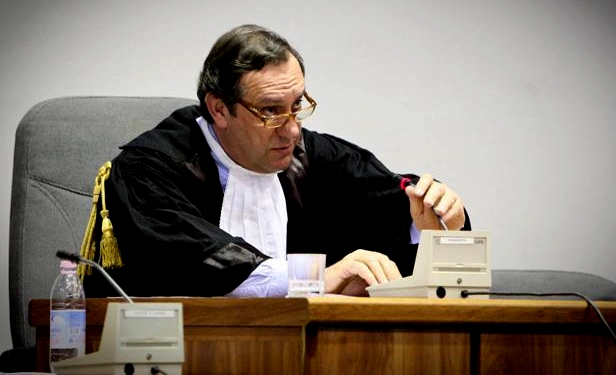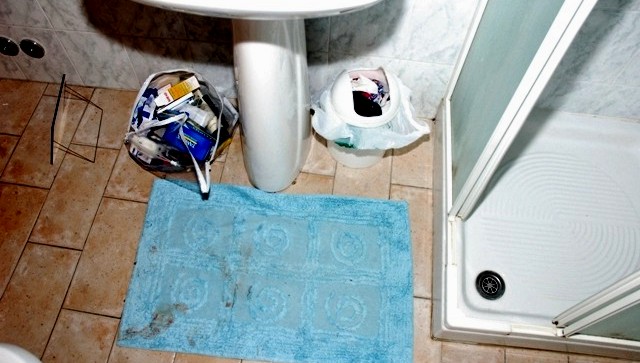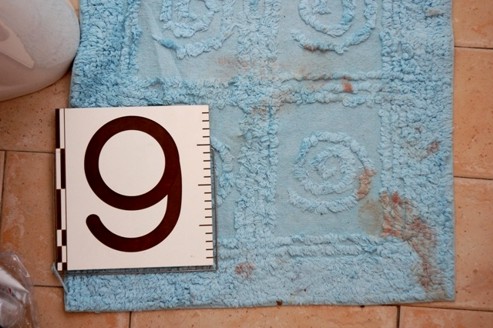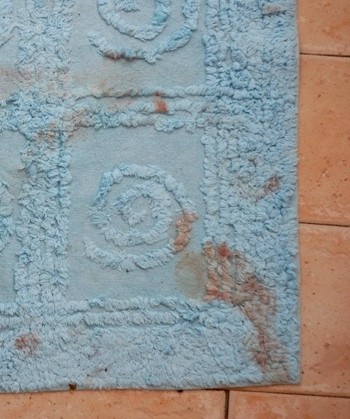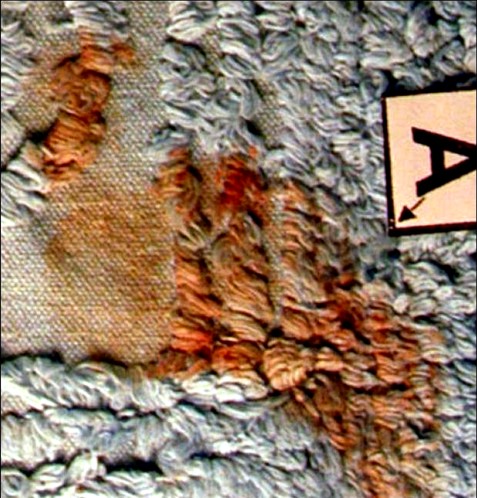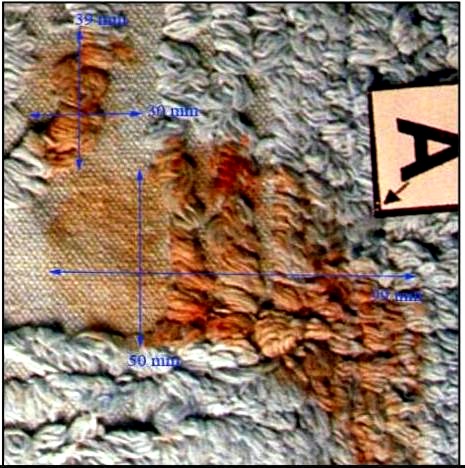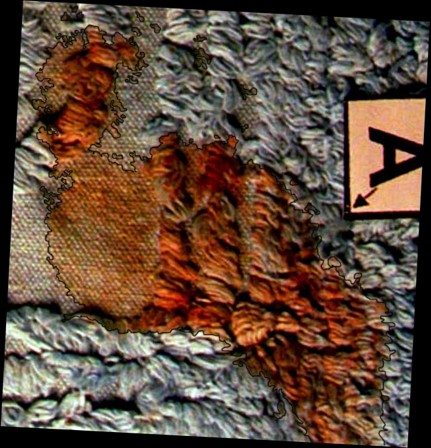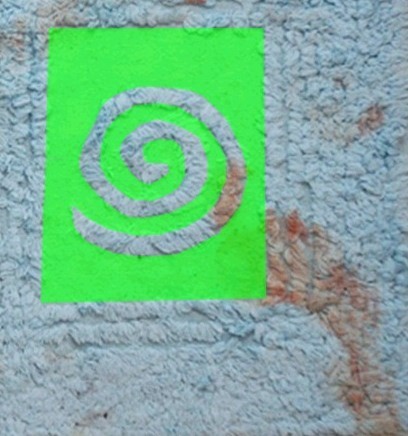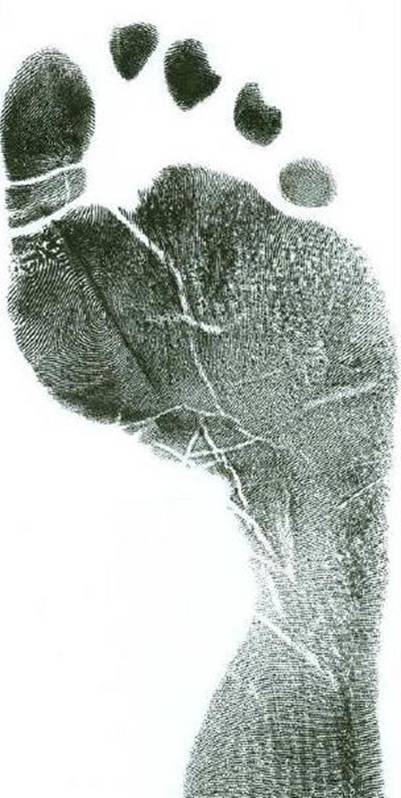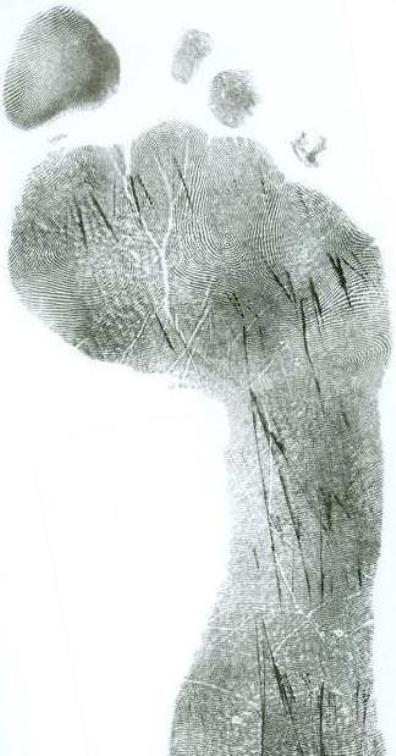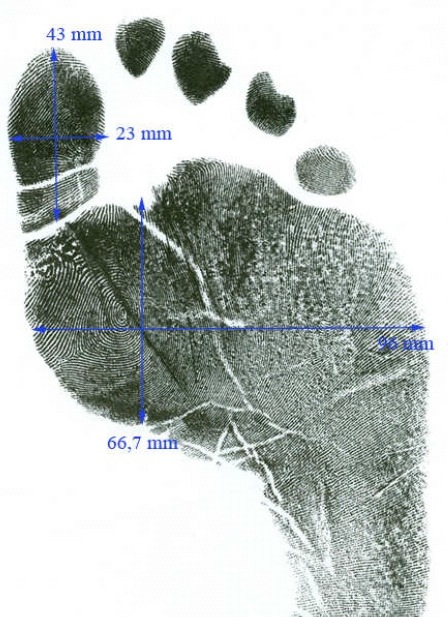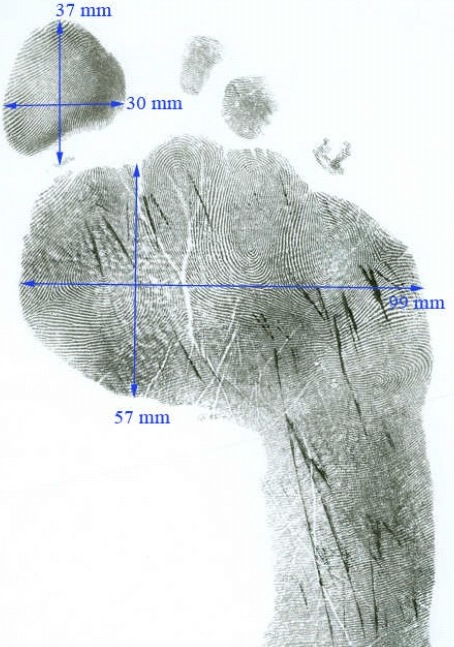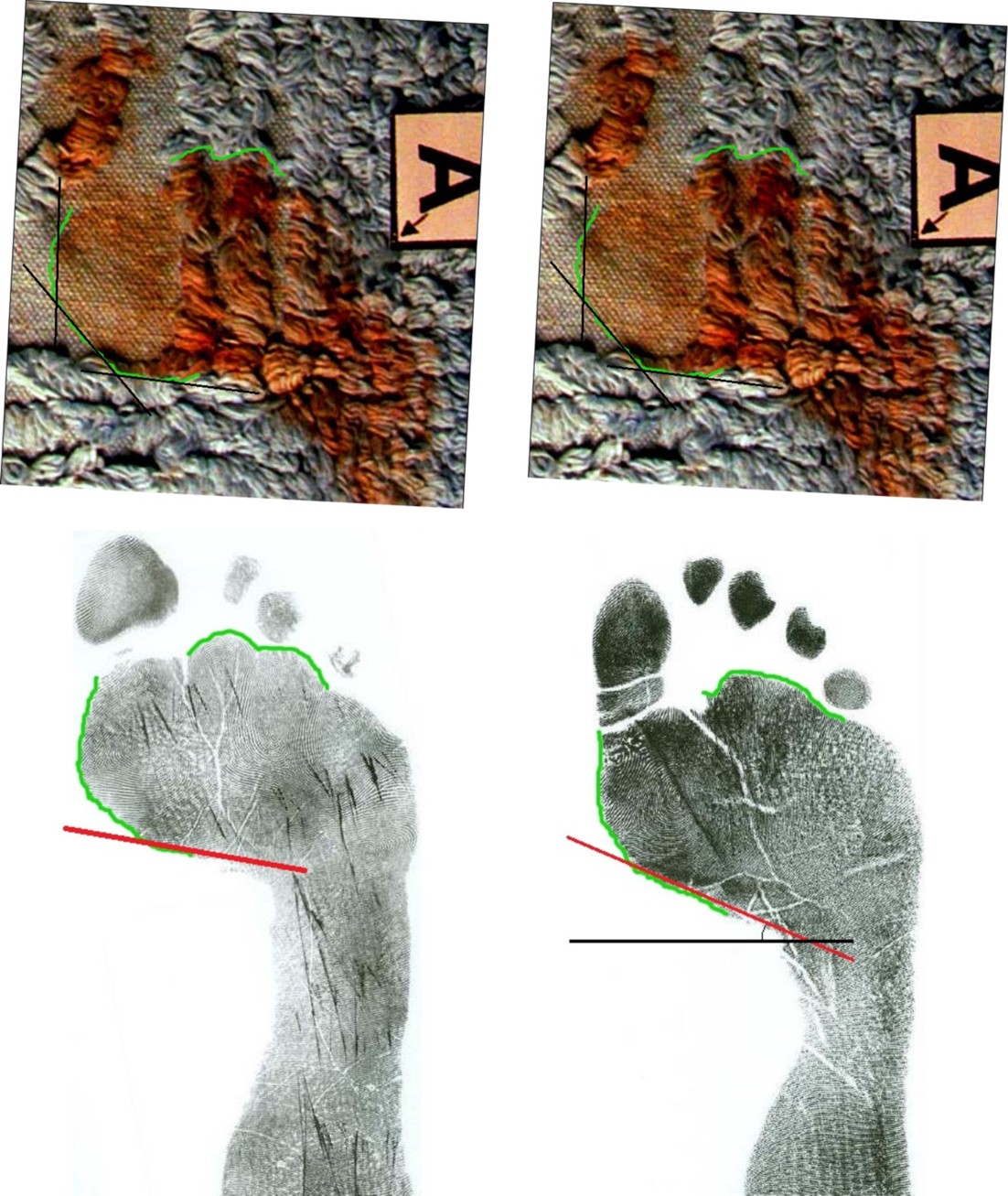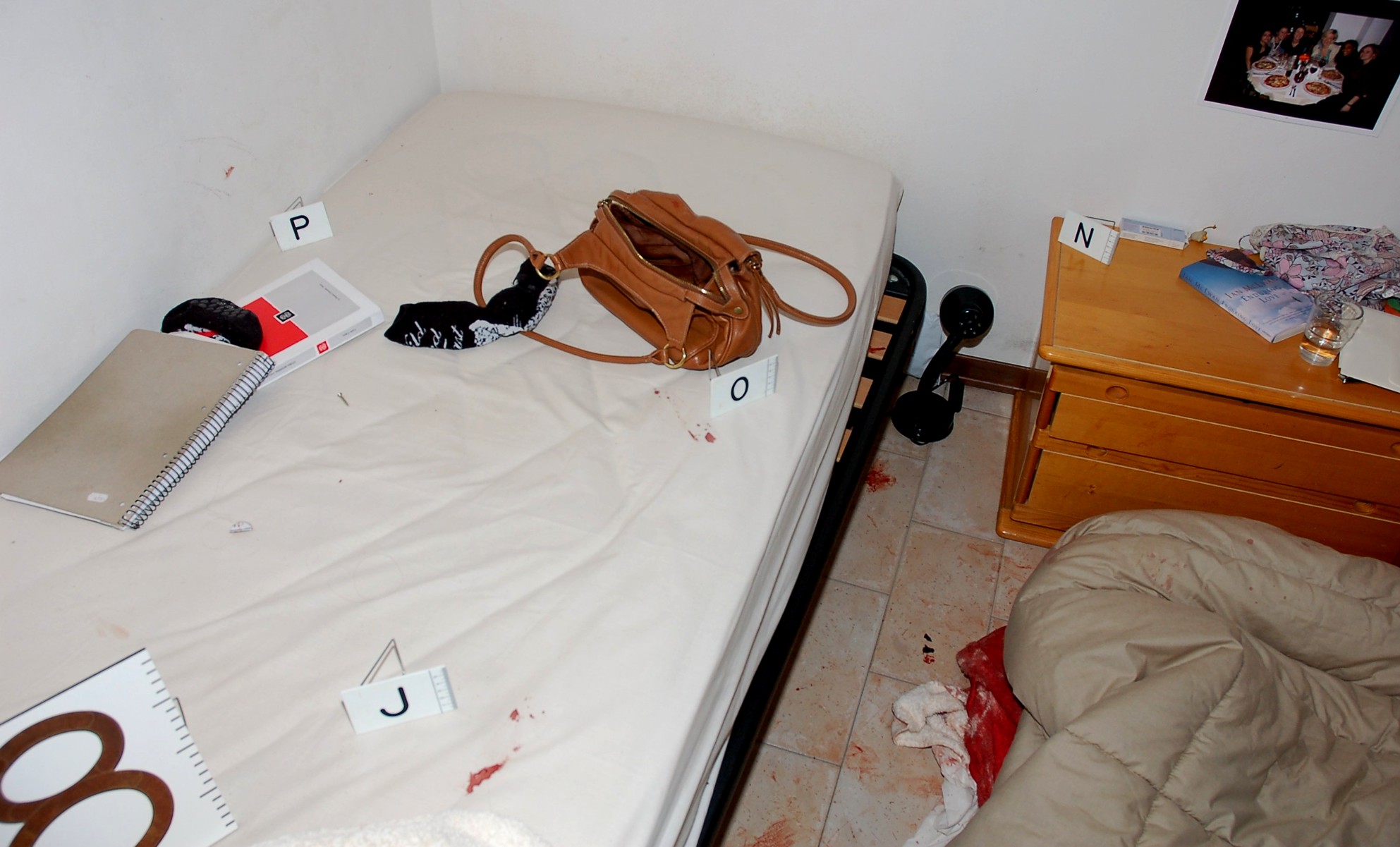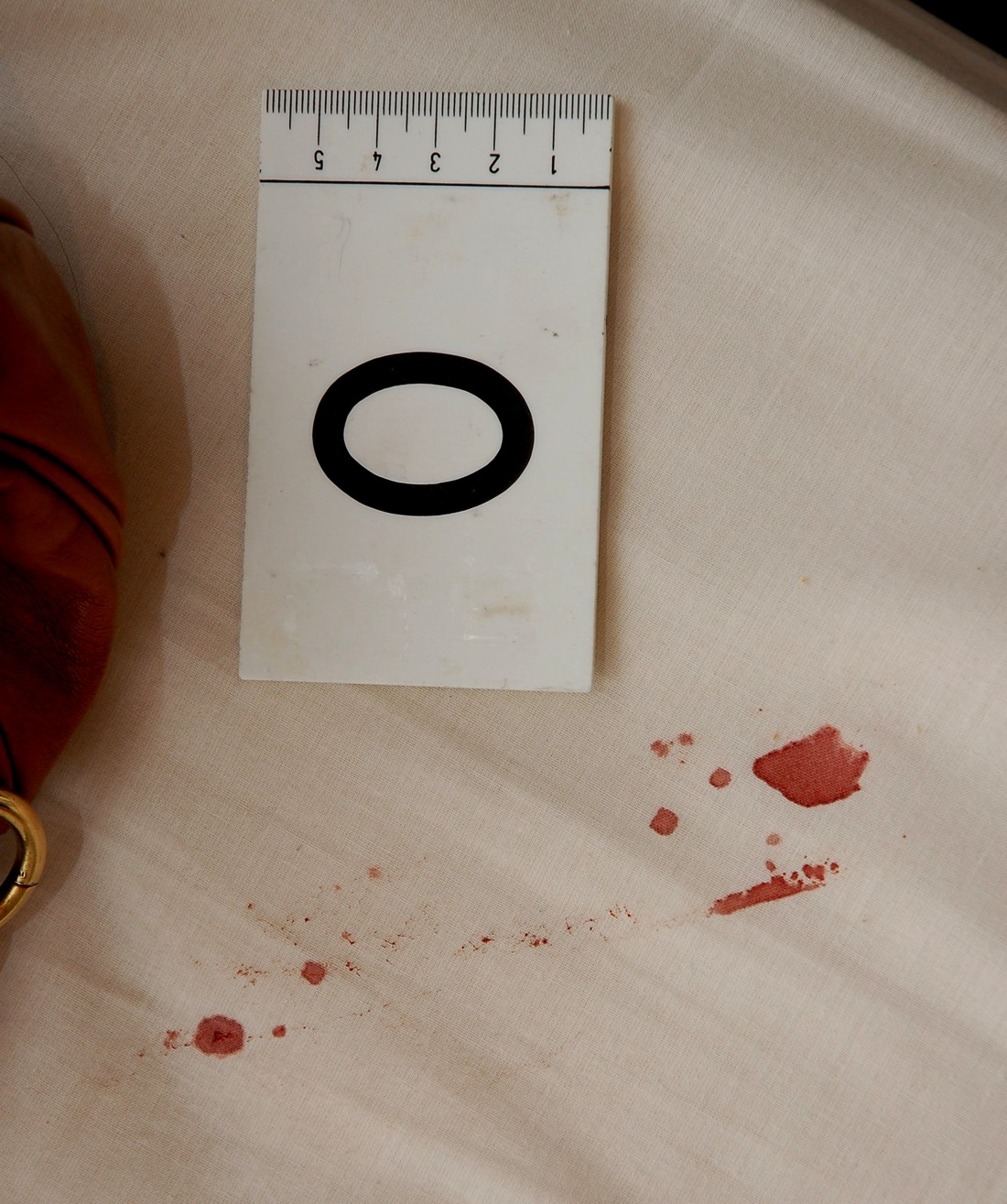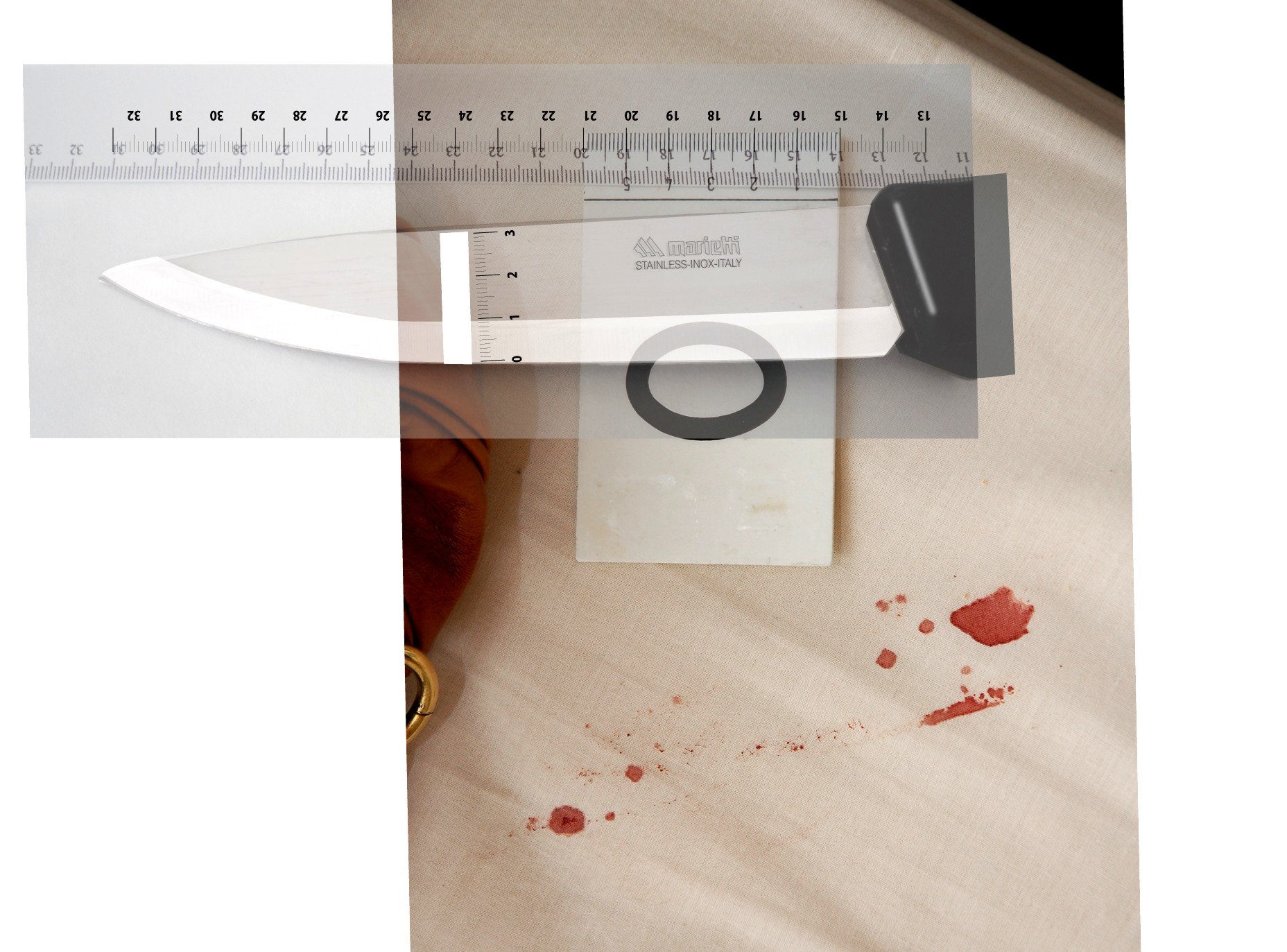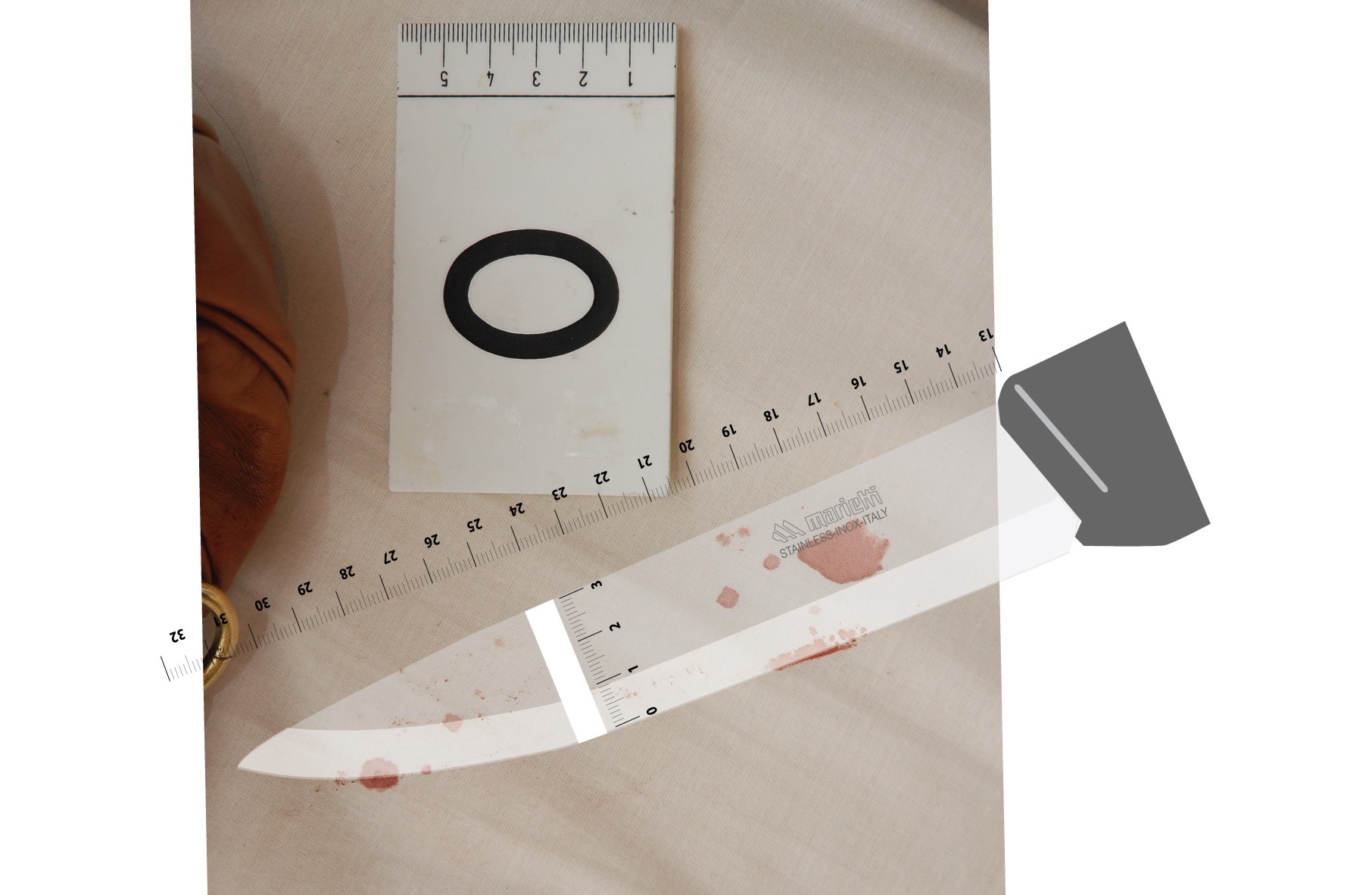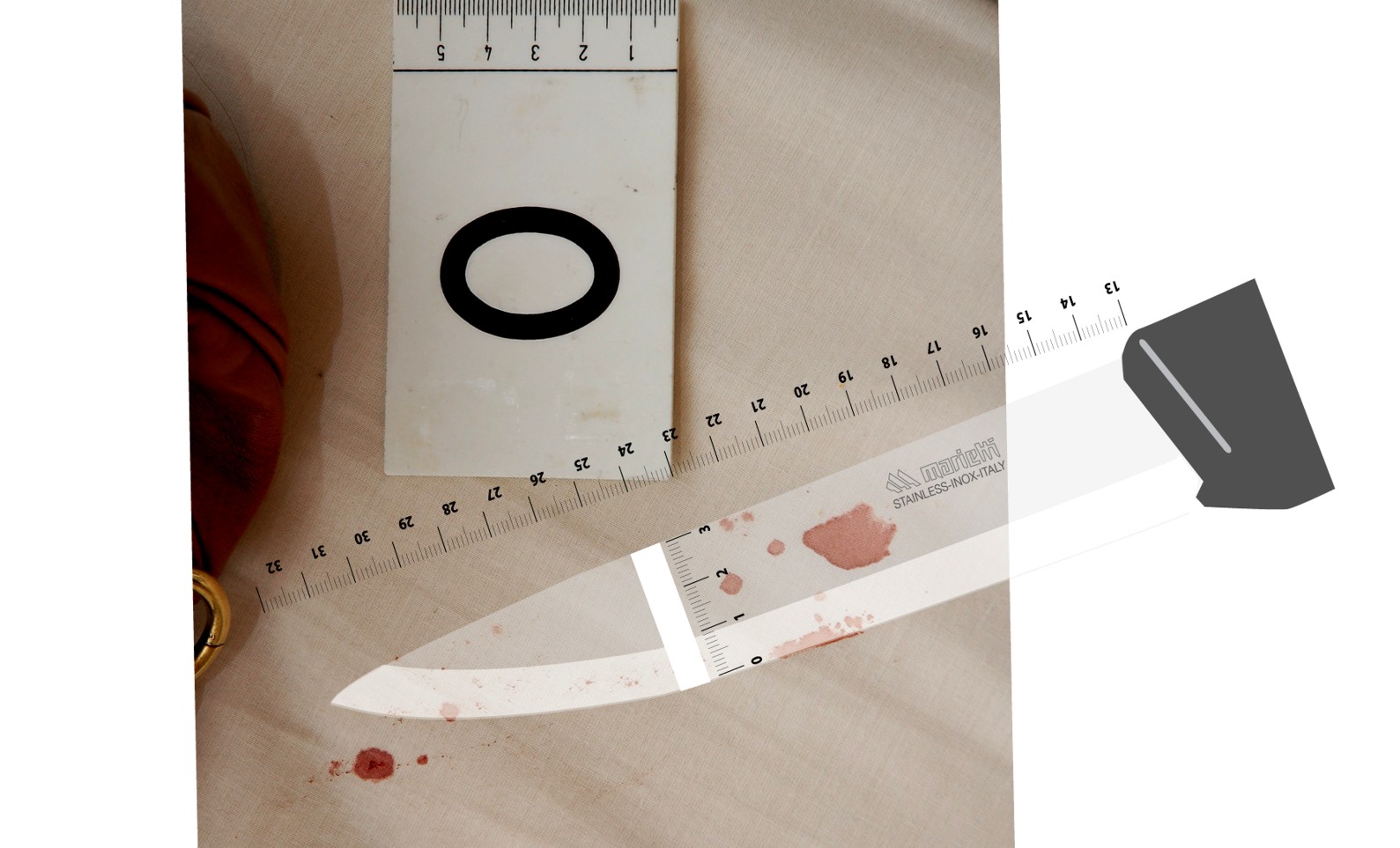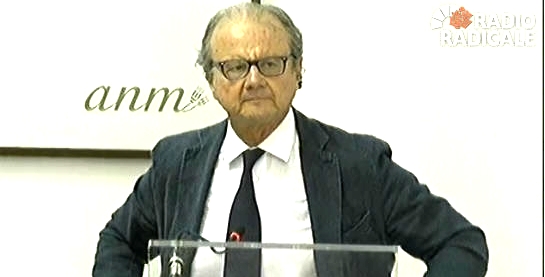
Category: DNA and luminol
Thursday, May 29, 2014
Ted “There Is No Evidence” Simon’s Tired Mantra Misinforms Americans And Provokes Italian Hard Line
Posted by Our Main Posters
No-evidence claim March 2013 contradicts tough-evidence claim Dec 2008
1. Is Ted Simon already fired?
Has Ted Simon been kicked off the Knox-Mellas team?
Ted Simon gets no mention on Knox’s website among the credits to her Italian legal and Seattle PR teams. He seems to serve zero useful purpose to anyone that we can see.
One could train a parrot to repeat “there is no evidence” for a smaller fee.
Ted Simon is certainly not helping Knox to get back to Planet Earth - in January Judge Nencini awarded her another year inside, and for continuing legal incautions Knox could certainly face more time.
As he seems utterly ineffective on all fronts, maybe it was high time that Ted Simon was gone.
2. If so five good reasons why
A year ago, he seemingly allowed (1) this false felony charge to be included in Knox’s book.
That malicious claim could result in more prison time for Knox, and maybe even open Ted Simon to a malpractice suit, for zero due diligence done on Knox’s book. Since then, Amanda Knox has shot herself in the foot four more times, at least, with no obvious legal restraint.
Knox charged ahead with (2) the insulting and inaccurate email to Judge Nencini, (3) the insulting and inaccurate appeal to the European Court of Human Rights, (3) the insulting and inaccurate first response to the Nencini Report, and the insulting and inaccurate website that Knox runs.
3. Seven more good reasons why
Our interest is for justice for Meredith and her family, for Italian justice to be seen in a fair light, and for an end to this protracted PR-driven dead-end fight, in which Ted Simon has had some hand.
So let us look at some other ways in which Ted Simon’s lazy mantra, a substitute for a convincing alternative scenario of the crime, gives, or at least gave, Amanda Knox false hopes and will ultimately let her down.
1. Take a look at this absurd claim by Ted Simon which millions of Americans now, large numbers of lawyers, and many TV hosts can laugh off as simply untrue.
“There was no hair, fiber, footprint, shoe print, handprint, palm print, fingerprint, sweat, saliva, DNA of Amanda Knox in the room where Meredith Kercher was killed,” attorney Theodore Simon told TODAY’s Savannah Guthrie. “That in and of itself tells you unassailably that she is innocent.” (CNN)
What exactly does that mean? Does Ted Simon even understand the scenario of the attack? This was a KNIFE attack, which does not usually see the exchange of a lot of DNA. There was the indisputable use of two knives in the attack - and Knox’s DNA is absolutely incontrovertibly on one.
Why does Ted Simon make no mention of that?
2. Meredith’s room was not fully swabbed for DNA because fingerprint dusting was the investigators’ (right) first choice. There were no fingerprints there - but there were none in Knox’s room either. Was she never there too? Knox’s lamp was found in Meredith room, with no prints. It would not have got there without help from her. There was a Knox-size shoeprint in the room. It would not have got there without help from her.
Why does Ted Simon make no mention of that?
3. Throughout the rest of the real crime-scene, which Ted Simon would really, really like Americans to forget includes a corridor, two bedrooms, and two bathrooms as well as Meredith’s room, there is stacks of unshaken forensic evidence against Knox. Indisputably a partial cleanup occurred because some footprints in several chains had been disappeared.
Why does Ted Simon make no mention of that?
4. There is, if anything, a surfeit of possible motives (not that there is a requirement for certainty there), and certainly there is a surfeit of alibis. Knox clearly framed Patrick. She was totally unprovoked by police, and yet even after three years actually served for felony framing, she continues to perpetrate the great hoax that she was.
Why does Ted Simon make no mention of that?
5. Amanda Knox is ever more frantically claiming that Rudy Guede carried out the crime against Meredith alone, and yet there is zero question of that. Many myths spread about Guede are untrue.
Why does Ted Simon make no mention of that?
6. Raffaele Sollecito was absolutely incontrovertibly in the apartment during the attack - his own lawyers have failed to prove the print on the mat was not his. Absent Knox, it is inconceivable that Sollecito was there.
Why does Ted Simon make no mention of that?
7. Finally dozens of lawyers are saying that the extradition treaty with Italy is crystal clear. If due process to a conviction was followed - and the American Embassy in Rome monitored it and saw nothing wrong - Knox could be on a plane within weeks to pay for what was a very cruel crime.
Why does Ted Simon make no mention of that?
4. Free! New Ted Simon mantras
Due to sudden problems with Ted Simon’s gibberish machine, we are happy to step up and provide these for free.
There was no hair, fiber, footprint, shoe print, handprint, palm print, fingerprint, sweat, saliva, DNA of Rudy Guede in the bathroom where there was a bloody footprint of RS and DNA of Knox,” attorney Theodore Simon told TODAY’s Savannah Guthrie. “That in and of itself tells you unassailably that Guede did not do the crime alone.”
There was no hair, fiber, footprint, shoe print, handprint, palm print, fingerprint, sweat, saliva, DNA of Rudy Guede in Filomena’s room where the breakin was staged, though there was Knox’s DNA” attorney Theodore Simon told TODAY’s Savannah Guthrie. “That in and of itself tells you unassailably that Amanda Knox is framing him.”
There was no hair, fiber, footprint, shoe print, handprint, palm print, fingerprint, sweat, saliva, DNA of Amanda Knox in the bedroom where she slept,” attorney Theodore Simon told TODAY’s Savannah Guthrie. “That in and of itself tells you unassailably that Knox did not even live in the flat.”
Look for them soon, on your local TV.
Tuesday, April 29, 2014
Why Final RS & AK Appeal Against Guilty Verdict May Fail: Multiple Wounds = Multiple Attackers
Posted by Our Main Posters
Reports From Italy On Why AK & RS Appeal Failed
The Nencini Report has been released and we are seeing to its translation right now.
Meanwhile journalists in Italy have these reports which convey the very implacable, damning tone. There was nothing accidental about Meredith’s death; Knox premeditated it all along.
First report
From Il Messagero kindly translated by Miriam:.
FLORENCE - The knife that was seized at Raffaele Sollecito house is the knife that killed Meredith Kercher, and the blow was delivered by Amanda Knox. So writes the President of the Court of Appeal of Florence, Alessandro Nencini, in the motivation report of the sentence that was passed on Jan. 30th that saw Amanda Knox sentenced to 28 and a half years and Raffaele Sollecito to 25 years.
Over 330 pages in which the court covers the appeal and explains the conviction. Starting with the knife considered “not incompatible with the wound that was carried out on Meredith Kercher. “In the present case, writes Nencini what counts is the accessibility of the weapon by the accused, it’s concrete portability from house to house, it’s compatibility with the wound, and the presence of Meredith’s DNA on the blade. All of these elements ascertained by the court lead to the conclusion that the knifed evidenced as no. 36 was one of the knifes used in the attack, and was the knife that Knox used to strike the fatal blow to Meredith’s throat.”
The court retains to have sufficient evidence of “certain reliability” of Rudy Guede (convicted to 16 years) Amanda and Raffaele in the house where Mez was killed, on the night between the 1st and November 2, 2007 in 7 Via della Pergola “in the immediate phases following the murder.” The Court then tells how she was immobilized and Mez “was not able to put up some valid resistance because she was dominated by multiple assailants and cut at the same time with the blades of several knives.”
Rejected therefore is the defense’s strategy of both of the convicted, that have always maintained that the killer was only one.: the Ivorian Rudy Guede.
Second report
Bullet points from various Italian media.
- The big knife from Sollecito’s house held by Amanda Knox caused the fatal wound to Meredith while the other was held by Raffaele Sollecito.
- There is strong “multiple and consistent” evidence of all three in the house immediately following the murder. All three worked to suppress Meredith.
- There was an escalating quarrel between Knox and Meredith leading to a progressive aggression and murder with sexual components.
- Between Amanda and Meredith there was no mutual sympathy and Meredith harbored serious reservations about the behavior of AK.
- The biological trace found on the bra clasp that Meredith Kercher was wearing the night she was murdered was left by Raffaele Sollecito
Third report
No especially accurate reports in English have appeared yet and the erroneous “new trial” is still surfacing. Andrea Vogt tweets that she will be posting an analysis soon.
The mischievous defense-inspired “sex game gone wrong” and “satanic theory” mantras are still widely showing up in the duped media, but are nailed hopefully finally in this new report.
Judge Nencini has closely followed and endorsed the “from all angles” Massei trial analysis, but with the inclusion of some more credible explanations from Prosecutor Crini which Judge Micheli had also espoused back in 2008.
In particular, Rudy Guede is not now highly improbably seen as the one initiating the attack on Meredith, and sex was not at all the primary driving force for the attack (the prosecution never ever said it was). Knox carried the big knife from Sollecito’s for a purpose.
The bad blood between the girls resulting from Knox’s crude, brash, very lazy, drug-oriented behavior was well known in Meredith’s circle. All of them had backed away from her, as also had her employer and the patrons in his bar.
There was a probable theft of money by Knox who was unable to account for a sum similar to what Meredith would have stashed away for the rent and that is seen as the probable spark for the explosive argument and attack.
Fourth report
Barbie Nadeau in The Daily Beast
Amanda Knox apparently did not kill Meredith Kercher in a “sex game gone wrong,” as had been previously decided by a lower court in Perugia, according to a Florentine appellate judge who released today a 337-page document explaining his decision to convict Knox and her erstwhile Italian boyfriend, Raffaele Sollecito, for Kercher’s murder. Rather, the judge claims, Knox allegedly killed Kercher, her 21-year-old British roommate, because she didn’t like her.
All Italian courts require judges to explain the reasoning behind their rulings, and it likely represents the penultimate step in a seven-year case that has seen Knox and Sollecito first convicted in 2009 then acquitted in 2011 then convicted again in January 2014. Rudy Guede, an Ivory Coast native who was also convicted for his role in the murder back in 2008, is serving a 16-year jail sentence. He is currently eligible to apply for work furloughs from prison.
Judge Alessandro Nencini, along with a second judge and six lay jurors, were tasked with hearing a second appeal that began in September 2013 after Italy’s high court threw out the acquittal that set Knox and Sollecito free in 2011. Italy’s high court cited “inconsistencies” and “legal mistakes” and tasked Nencini’s court with hearing the appeal again. It was not a retrial per se, but rather a fresh look at the appeal process that freed Knox.
Nencini decided that the appellate court that set Knox free erred in evidentiary and legal matters. That court will now have to rule definitively on the case, using Nencini’s reasoning and whatever appeal Knox and Sollecito file for their final judgment. If the high court accepts Nencini’s verdicts, the two will be required to serve their prison sentences in Italy. Knox has vowed she will not return to Europe, but Sollecito, unless he escapes, won’t be as lucky.
The court’s explanation of its decision comes down hard on the first appellate court that overturned Knox’s guilty verdict, at times seemingly scolding them for misapplication of penal codes and for throwing out witness testimony without explanation. “It was an operation of evaluating evidence with using logic,” Nencini wrote, accusing the first appellate court of essentially throwing out testimony that allegedly proved Knox’s involvement, but keeping testimony that supposedly supported her innocence.
He used Knox’s prison diary as a prime example. “Look at the contradictions in the evaluation of the diary written in English by Amanda Knox,” he wrote, referring to a handwritten prison diary taken fromKnox’s cell as part of the investigation to determine why she accused her pub boss Patrick Lumumba of Kercher’s murder during early interrogations. “On one hand, the appellate court of Perugia completely devalued the writings when she admitted wrongdoing by accusing Patrick Lumumba. On the other side, they valued it when she defended herself.”
Nencini also ruled that there was plenty of forensic evidence tying Knox and Sollecito to the crime scene, writing “they left their tracks in the victim’s blood” more than once in the document. He accepted testimony that supported the theory that a knife found in Sollecito’s apartment was one of the primary murder weapons, and he reasoned that a second knife was also used that matched a blood stain left on Kercher’s mattress.
The first knife in question was the only hard evidence reexamined in the second appeal, and forensic experts ruled that a previously untested spot on the knife’s handle consisted of 100 percent Knox’s DNA. An earlier court heard testimony that a tiny smidgeon of DNA on the groove of the blade was Kercher’s, but the first appellate court agreed with witnesses who testified that the sample was too small to be considered a perfect match. The second appellate court not only considered the knife to be the murder weapon, it also ruled that Knox “plunged the knife into the left side of Kercher’s neck, causing the fatal wound.”
The second appellate court also reasoned that Kercher’s bra clasp, which had been cut from her body after she was killed, had Sollecito’s DNA on the tiny metal clasp. “The biological trace found on the bra clasp that Meredith Kercher was wearing when she was assassinated belonged to RaffaeleSollecito,” Nencini wrote, agreeing with the judge in the original murder conviction. “The clasp was manipulated by the accused on the night of the murder.”
The court also scoffed at certain rulings laid out by the first appellate court, saying that the court’s reasoning that it would have been easy for “a young athlete” like Rudy Guede to scale the wall and enter the apartment, was borderline racist.
Nencini also ruled that with regard to motive in the murder, it was subjective and personal. “It is not necessary for all the assailants to share the same motive.”
The court picked out small details of Knox’s presumably errant testimony, including how she told police the morning Kercher’s body was found that Kercher always locked her door “even when she takes a shower,” which was later contested by the girls’ other roommates.
Nencini also clearly believed ample forensic testimony, presented by experts examining the original autopsy, that Kercher was killed by more than one person. “”She was completely immobilized when she was murdered,” he said, reasoning that Guede could not have acted alone, and instead likely held her back as Sollecito and Knox knifed her.
The judge also pointed out incongruences in Knox’s testimony about the night of the murder, but noted problems with the other witnesses, which included a homeless man, an elderly woman who said she heard screams. Still, he ruled that Knox’s accusation of Lumumba is vital evidence against her. “It is impossible to separate the two acts,” he wrote.
Using Nencini’s reasoning, Knox’s lawyers now have the roadmap for planning their final appeal to Italy’s high court, likely later this year or in early 2015. However, this same high court threw out the acquittal in the first place, so Knox may need more than luck to walk free. If she is definitively convicted, she will likely face an extradition order to come back to Italy to serve out her sentence. There are very few legal loopholes that would allow an American citizen to escape a court decision by a country, like Italy, that shares extradition treaties with the U.S.
[Judge Massei at crime scene; report says why Knox & Sollecito appeal against his 2009 verdict has failed]
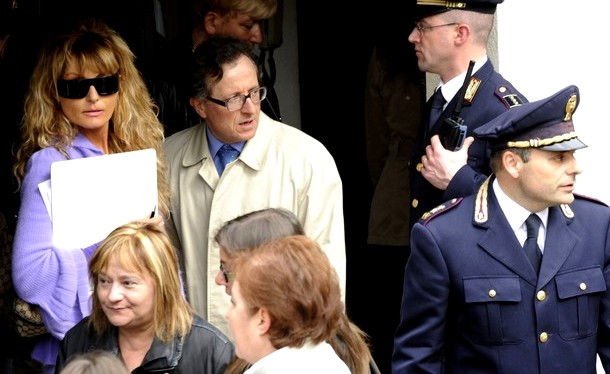
[The Supreme Court in Rome is expected later this year to confirm this outcome]

Wednesday, April 16, 2014
The Incriminating Bathroom Evidence: Visual Analysis shows the Footprint IS Sollecito’s
Posted by Machiavelli
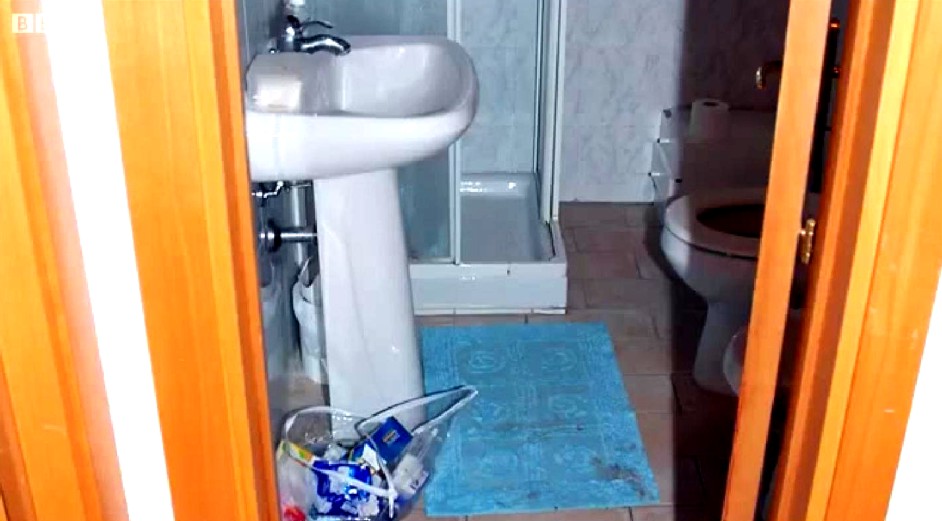
[Please click on each image for a larger and more high-resolution version]
The sheer depth and width of the hard evidence
The defenses really don’t want you to know this: in both width and depth, the full panoply of the evidence against Knox and Sollecito is absolutely overwhelming.
As we remarked in our post below there are far more and far stronger evidence points than UK and US courts normally require for conviction. But only the trial panel of judges observed anything like their full array.
The 2010 Massei Trial Report (which the Nencini Appeal court validated this past January) is a SUMMARY of what was presented to the judges in the courtroom. Those presentations in court were in turn something of a SUMMARY of the hard evidence buried in all the evidence files and the minds of witnesses.
Italian media SUMMARISED for Italians what was to be seen in the courtroom and to be read in the Massei Report. They were barely able to do even summaries for the 1/4 of all the trial hearings that were not open to the media or the public.
UK and US media for the most part didn’t even bother to provide comprehensive summaries (the very fine on-the-spot reportings of Andrea Vogt, Barbie Nadeau and Ann Wise were the main exceptions).
So in effect people in the UK and US attempting to follow the story didnt for the most part receive even a summary of a summary of a summary!
Not one US or UK newspaper or TV network translated the Micheli Report, or the vital Massei Report, or the Supreme Court appeal, or the Supreme Court outcome - only the (mostly professional) translators on PMF dot Org did all that translation.
This post is another example of how far down - beyond even Massei - it’s possible to drill into the evidence, and see it still hold up.
Some past posts on TJMK drilled down to similar depths, on the knives, on the DNA, on the mixed-blood traces, on the phone-events, on the motives and psychologies, and so on. All that evidence too all held up.
Visual analysis of the bathroom-mat footprint
This post mainly consists of high-resolution pictures and measurements. Presented like this, the pictures and measurements largely speak for themselves, and show the real strength of the bathroom-mat footprint evidence.
You will see that as SomeAlibi previously concluded using other methods, this footprint was quite undeniably Sollecito’s. It bears no similarity at all to Rudy Guede’s.
Please click on all images for larger versions in scalable PDF format
1 . [Below] the bathmat and the print, with measurement reference
2 . The bathmat print and the surrounding area
3 . The bathmat print (photo from Polizia Scientifica).
4 . The bathmat print, with vertical and horizontal sizes, from Rinaldi’s report
5. The bathmat print, photo with enhanced contrast.
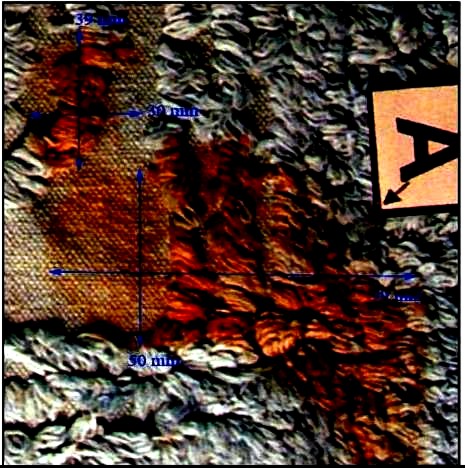
The photo above was modified by highly enhancing contrast.
6 . Enhanced contrast helps to spot some features
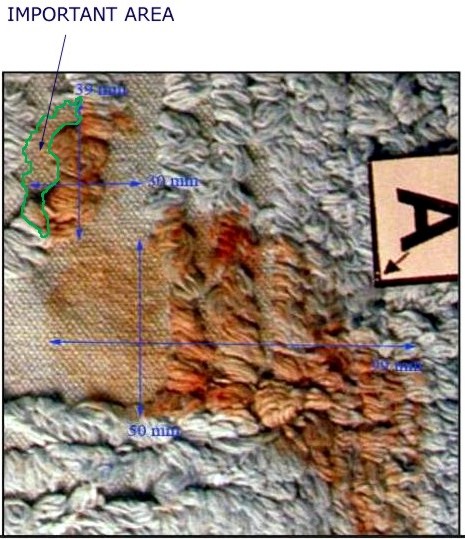
Contrast may help to highlight especially some parts of the print outline.
For example the area on the left labeled as “important area” in the picture (which was “forgotten” in the notorious photo elaborations disseminated by the ‘Friends of Amanda’ group), shows the actual left outline of the “˜big toe’ of the bathmat print.
The toe includes the area indicated in this picture (here the picture is shown again in its original colours).
7. The bathmat, with enhanced contrast
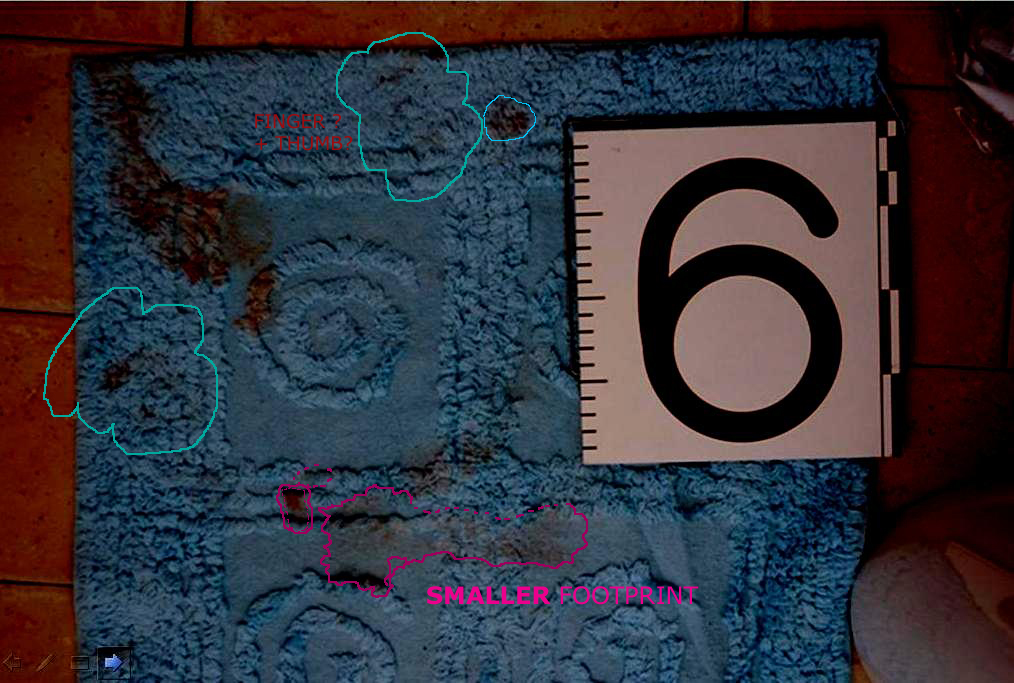
The contrasted image is showing the presence of other stains
There are other stains on the carpet (about another 10, factually situated in one half of the mat area), and also there shows a second diluted footprint (apparently from a foot of smaller size).
8. The selection of a set of red colour shades, outlined by an automatic outline generator
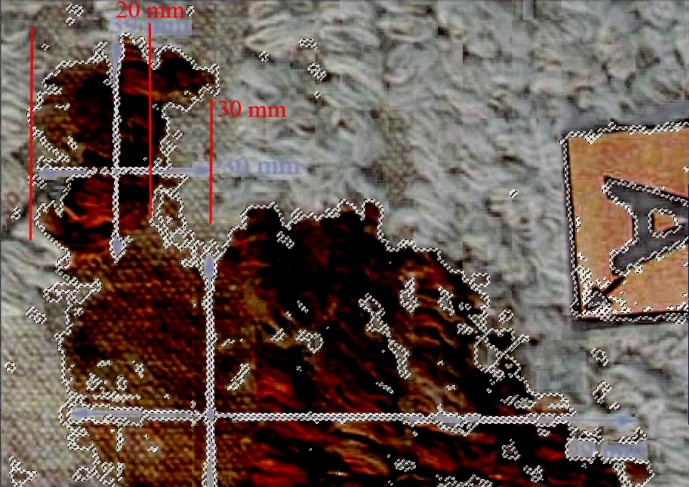
Shows the shape and the possible “˜outline’ of the stain
Reference measurements indicate the width of the “˜big toe’ in millimetres.
9 . A hand drawing of the outline (detail).
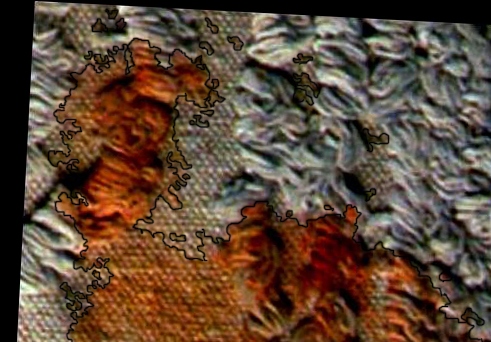
The photography above was modified
The modifications are: +28% contrast, -8% luminosity, + 20% colour saturation, from the original.
An outline has been drawn manually on the photoshop image, trying to be as faithful as possible to the actual stain.
You can notice that, apart from some minor “˜disputable’ very faint areas (such as the area between the toe and the metatarsus) there are only minimal differences between an automatically generated outline and a manually drawn one.
The shapes of the “˜big toe’ are extremely similar in both contours (images 8 and 9), in fact all meaningful features are basically identical.
We consider this manually drawn outline as good for comparison.
10 . The complete hand-drawn outline
11 . Minor detail: small dots separated from the main stain
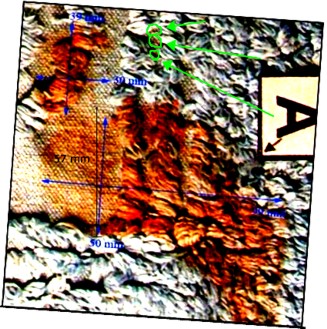
Observe the small red ‘dots’ in the picture above
Although we can’t draw any conclusion about their possible significance, we note the existence of these very small “˜spots’ of a faint red colour shade, separated from the big stain.
They are detected by the computer generated outline above, and that we also see as distinguishable with the naked eye thus we considered them in drawing manually the outline.
We don’t draw any conclusion about them; but because of their sensitive position (they may suggest a “˜small toe’ mark) we take note of them.
The green arrows in the picture point out their position (green circles).
12 . An image in electronically modified colours
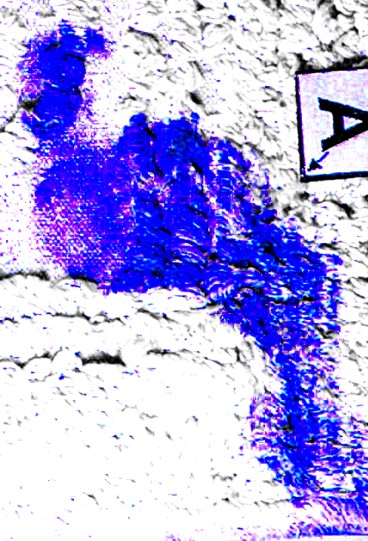
Distribution and intensity of the colouration
As a part of the preliminary study of the stain, we also produced this image above where the computer assigned an artificial colour to an array of shades of ‘red’, thus allowing to further isolate the stain from the background for further assessments about its shape.
This picture shows the distribution and intensity of the colouration. (note: the existence of some above mentioned tiny marks is recorded by this technique too)
13 . The bathmat has a spiral-shaped relief decoration
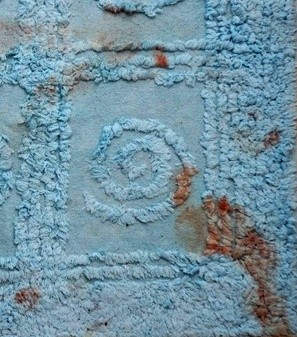
The footprint’s toe obviously balancing on top of the relief decoration.
We think the outline of the “˜toe’ mark of the bloody footprint is affected by the shape of the decoration, in particular the missing part of the toe on the right side, which is remarkably coincident with the margin of the decoration.
So that on that side there is a striking correspondence between the outline of the “˜negative area’ ““ the fabric surface around the spiral, which is lower ““ and the big toe’s outline
This indicates that the outline of that mark on that side was affected by the decoration margin, thus the print there has a “˜missing part’. So the “˜crooked’ bloody area in fact follows the margin of a larger toe.
Because of such coincidence, we can logically assume that the actual shape of the big toe mark appears to be part of a big toe, with larger surface which left its print only partly because part of its surface did not have contact with the fabric, in correspondence of the “˜negative area’.
14. The “negative area”
15. Mat decoration in relief and the toe mark
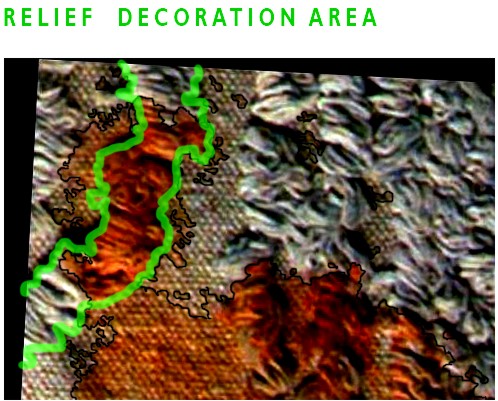
Observe above one single, unitary stain
The remarkable coincidence between the outlines of the decoration in relief and of the toe mark is shown in the picture above.
The rough contour of the print obtained through a smooth curve highlights the shape of the big toe.
Part of the relief decoration outline coincides with the toe mark outline, which shows, highlights and explains how all parts of the red toe mark, that you can see left of the relief decoration, they all belong to one single, unitary stain.
Thus we can deduce that the “missing” area on the right of the toe is determined by the decoration, and coincides with the negative area.
16. Picture (by Kermit) showing a rough shape of the stain
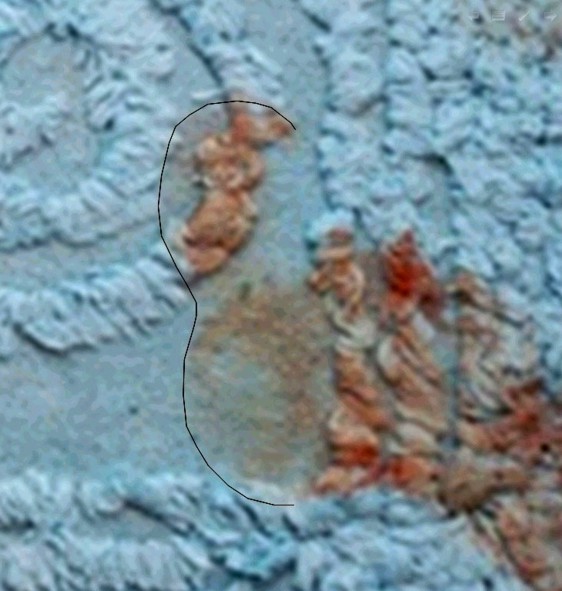
Observe shape, curvature and size
This drawing by Kermit above highlights the rough shape, curvature of left margin and overall size of the big toe.
17. Rudy Guede’s sample print
A copy of this picture together with one of Sollecito’s print at the same scale will be used for comparisons.
18 . Raffaele Sollecito’s sample print
A copy of this picture together with one of Guede’s print at the same scale will be used for comparisons.
19. Part of Rudy Guede’s sample print with Rinaldi’s reference measurements
20. Part of Sollecito’s sample print, with Rinaldi’s reference measurements:
21. Bringing all photographs down to the same scale
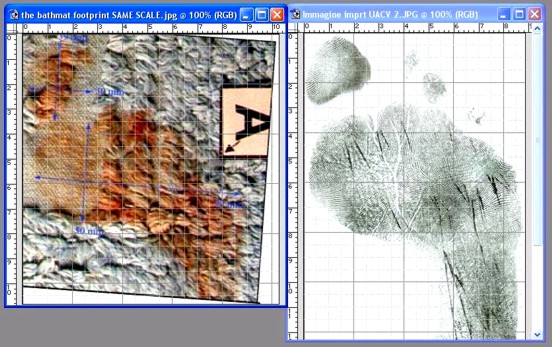
An accurate exercise of scaling was done
This was based on Rinaldi’s referenced pictures. Each one of the Rinaldi’s sample pictures has multiple measurements on several points of reference which allow a high precision determination of their scale and sizes, and thus comparison at the same scale.
In order to further increase scaling precision, the scale was calculated previously and separately for each comparative measurement in the three photos; this was done multiple times for each measurement and the average was picked in order to reduce error as for statistical measurement method.
The resulting final error in the scale is extremely small, far below a threshold of significance that could affect comparison (which was set arbitrarily at 1%, but it’s probably significantly higher, while the actual error is much lower).
In other words, the scale error that may affect your screen pictures will be definitely smaller than any possible perceivable (either significant or tolerated) difference that would be noticed or that may affect the attribution of the stain, when this is compared to the sample.
22. The hand drawn outline is shown again here
23 . The outline (matched scale) overlapped on Sollecito’s sample footprint
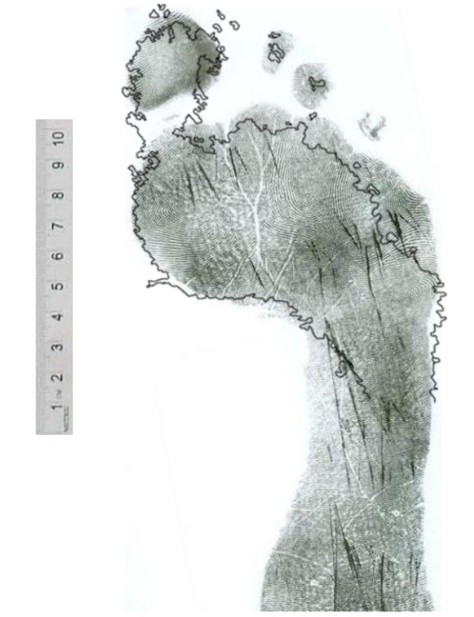
The array of compatibilities with Sollecito
The bathmat stain does not seem to have major incompatibilities with Sollecito’s print; it shows rather an array of compatibilities that can be perceived visually.
One interesting feature is the shape, size and position of a ‘big toe’, that appears as a remarkable coincidence; the toe also has a kind of cleft (see 28 below) on the curvature of its left margin. Another outstanding coincidence is the curvature of the plantar arch on the left.
24 . The same outline overlapped on Guede’s footprint
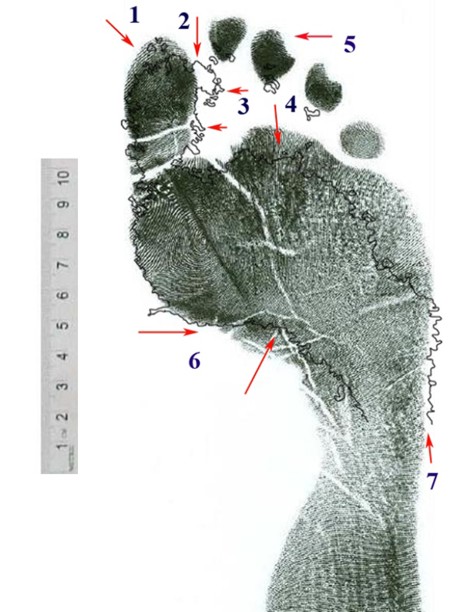
Compare with Guede’s - matched scale.
If you look at the overlapping of the stain outline (see pic 22.) with the sample of Guede’s print (see pics 17. 19.), you may notice 7 major differences, showing a failure of compatibility. Those differences are indicated by numbers (1-7) in the picture .
Each one indicates an area of major difference between the outline of the bathmat stain and the outline of Guede’s sample print. Those measurement differences are remarkably larger than those that can be detected on the overlapping with Sollecito’s sample print.
On the other hand, the compatibility between Sollecito’s print and some very peculiar aspects of the bathmat print (such as a 30mm wide and short toe) were absolutely remarkable.
The differences between the bathmat stain and Guede’s print are :
1) Toe mark of stain is significantly SHORTER than the big toe in Guede’s sample print (a difference of about 7 millimetres). Some people may want to attempt an objection, by suggesting that such a difference may be just a consequence of the position chosen for the overlapping, that maybe the bathmat print was just positioned too low in the picture, the problem may be solved by shifting it up about 7 millimeters so as to make the tip of the bathmat toe ‘coincide’ with the tip of Guede’s print toe.
However, such objection wouldn’t work; it’s a wrong argument. In fact the only possibly correct position for overlapping the bathmat stain outline is determined by the left curvature of the ball of feet and plantar arch (the area of the picture near number 6), which is by the way the most clearly outlined part of the bathmat stain. If you shift the bathmat stain upwards, the outline will miss the match with the curvature of the left margin of the ball of the feet. You will notice that the plantar arch in this area is already very incompatible with Guede’s plantar arch. It tends to become even more incompatible the more you shift the bathmat stain outline towards the toe.
The problem has no solution, since the more you shift the stain outline upwards (in the direction of the toe) in an attempt to make it look more ‘compatible’ with the length of Guede’s toe (or with an upper margin) the more it will become incompatible with the plantar arch. In order to limit the incompatibility of the plantar arch, and in order to keep an overlapping of at least the left margin of the ball of the feet, you need to place it as shown in the picture, this is the position of ‘maximum’ compatibility between the bathmat stain and Guede’s print. Conclusion: the bathmat toe is too short.
2) Toe mark of stain is TOO WIDE (30 mm). It is much wider (30 mm) than Guede’s toe. The number 2. indicates the protruding mark at the upper right, the mark which Giulia Bongiorno desperately insisted on calling a “second toe” mark. In fact, not only would the mark miss completely any hypothetical Guede’s ‘second toe’ in any possible position of the print; also you may notice (highlighted by pics 8. and 9.) how it is not a “mark” itself, but actually it just part of the same area which is entirely continuous in shape and coloration with the rest of the toe mark, and - the most remarkable feature - its right outline is coincident with the outline of the spiral-shaped relief decoration, so that you can reasonably conclude that it is determined by that (the missing area at the lower right of the ‘big toe’ is determined by the existence of the “negative area” of the bathmat decoration).
Conclusion: the bathmat stain has a wider toe mark, however one likes to call it (“big toe”, or “big toe + second toe”) that fails to match any possible part of Guede’s print. The bathmat print is clearly different and incompatible with Guede’s print. It simply cannot be overlapped to any part of Guede’s sample print. Such area is a very significant difference that points outright to incompatibility between the stain and Guede’s print.
3) The toe mark is larger also in the area located at the lower portion of the toe. The toe of the bathmat print in fact has a ‘right margin’ which actually has some additional small marks, small drops protruding towards the right, like droplets maybe produced by the wet cotton fibres of the part in relief which protrude towards the right. This tends to suggest the toe area of the stain may in fact be considered wider: the object that produced it was definitely wider than 22mm, in this area of the toe as well. So also a look at this area confirms that the bathmat stain is wider than 22-23 mm (more towards 30 mm) not just when measured at the upper corner (number 2.) but also at its “lower” parts; here, the small marks caused by the liquid suggest that a larger surface has squeezed liquid from some fabric threads leaving some trace also on the lower area.
4) Bigger incompatibility of Guede on the metatarsus front outline. This area is the front outline of metatarsus: the stain is almost 1cm shorter than Guede’s metatarsus. This happens when you chose the overlapping so as to make the left outline and plantar arch (6.) of metatarsus coincide, as in the picture. Sollecito’s sample print also shows some difference from the stain in this area (pic. 23.) but the difference between the stain and Sollecito’s print is significantly smaller than what you can see in Guede’s print.
5) There are NO SMALL TOES in the bathmat stain. Small toes are completely absent from the bathmat stain (while the tiny blood marks around the stain don’t coincide with their expected position if it was Guede’s print). Such lack of small toes is a peculiarity of the bathmat print. This is a remarkable difference from Guede’s print, and at the same time, a considerable analogy with Sollecito’s print. In fact one outstanding feature of Guede’s print is the evidence that Guede places a big load of weight on his small toes while instead Sollecito has a posture with a weight distribution with the contrary tendency, and obviously he almost does not touch the ground with his small toes.
Thus, Guede’s small toes are all very well pressed on the ground and thus, we can reasonably infer they are somehow naturally likely to get wet if he steps on any wet surface, and anyway they should get wet for sure if the foot is immersed in water or washed (the foot that left the bathmat print must have been immersed in bloody water). The murderer supposedly washed his foot then stepped on the bathmat. In order to attribute the print to Guede we should assume that Guede “forgot” to touch the carpet with his small toes (while instead he puts a lot of weight on them) or that he managed to not rinse them.
6) The outline of the stain has a PLANTAR ARCH that COINCIDES, by curvature and angle, with the plantar arch in Sollecito’s print, while instead it is very different from the plantar arch of Guede’s print.
7) The stain is larger than Guede’s print metatarsus as visible in the right area of the stain. The difference is rather significant, almost half a centimetre, that is bigger than the difference with Sollecito’s print which instead coincides for a trait. This difference cannot be “solved” in any way since, even if one wanted to claim that the scale is wrong and that the stain should be sized down, this would make the toe, already too short (as in 1.) become even shorter.
If instead the toe length is adjusted the metatarsus becomes even less compatible with Guede. We recall that Massei found that Guede’s feet had a print overall more slender than Sollecito’s.
25 . Other features:
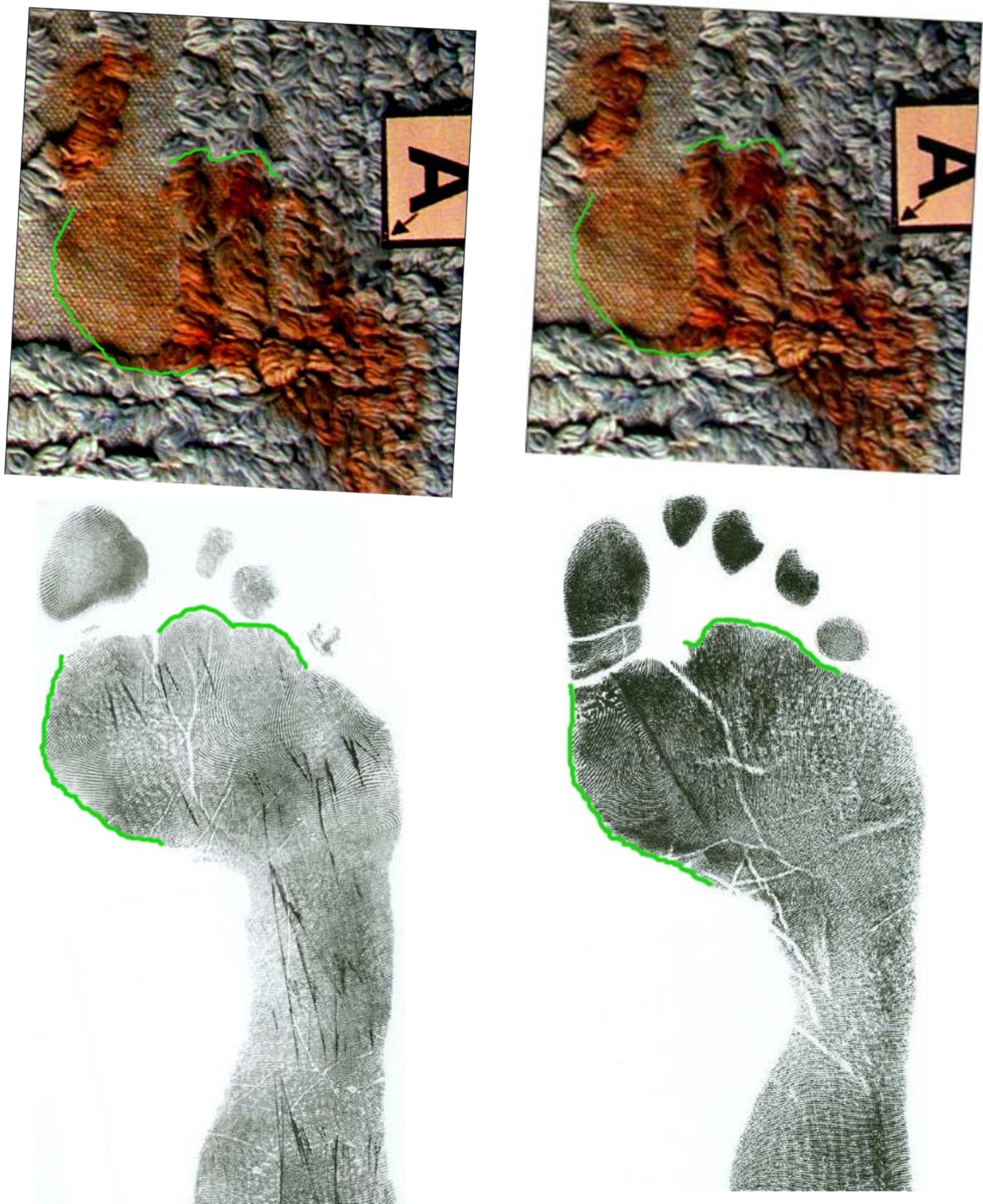
Curvatures of plantar arch are very different
The plantar arch curvature, highlighted in two different drawings (the second highlights also the upper outline “hunches”); the plantar arches in the two sample prints of Sollecito and Guede are shown below. The curvatures of plantar arch are very different.
26. The outline curvature generates different angles
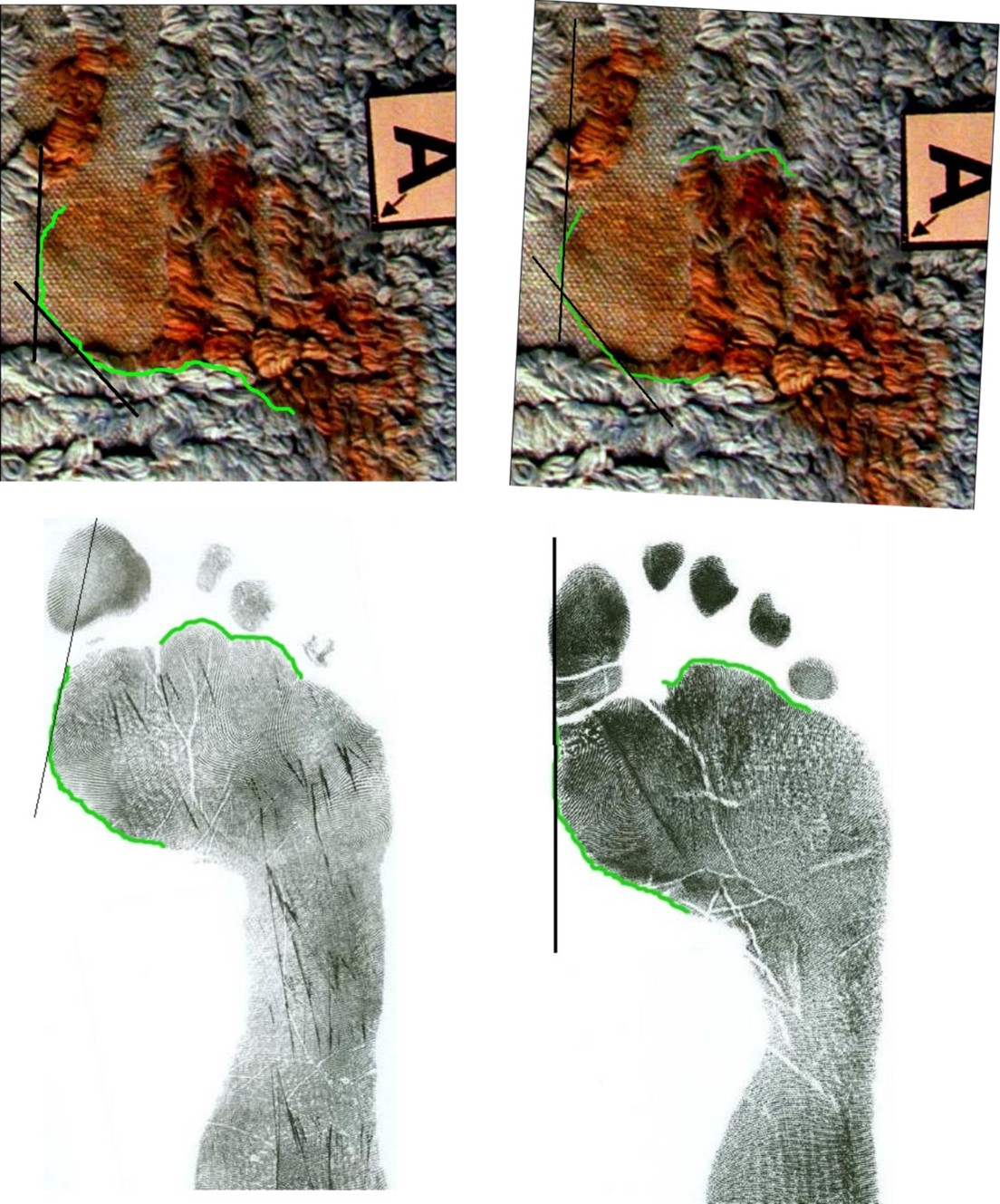
Sollecito’s and Guede’s plantar arch curvatures have very different angles. Also the left outline of metatarsus maintains a different curvature. Sollecito’s outline has an angle (see outline tangent) intersecting the toe (the metatarsus has a “bunion”); in Guede’s print there is basically no intersection, the outline and the toe form almost a straight line.
27 . Plantar arch curvature angle differs between Sollecito and Guede
If you consider the vertical axis of the sample footprint, and its orthogonal line, you may notice how the plantar arch curvatures of the two prints accomplish different angles: the two angles are VERY different, not just three or four degrees.
The (too) narrow angle of Sollecito’s plantar arch probably has a relation with the protruding outline and angle seen in pic 26., and seems related to a hallux valgus (which Guede does not have).
28 . The “cleft” on the left side of the stain
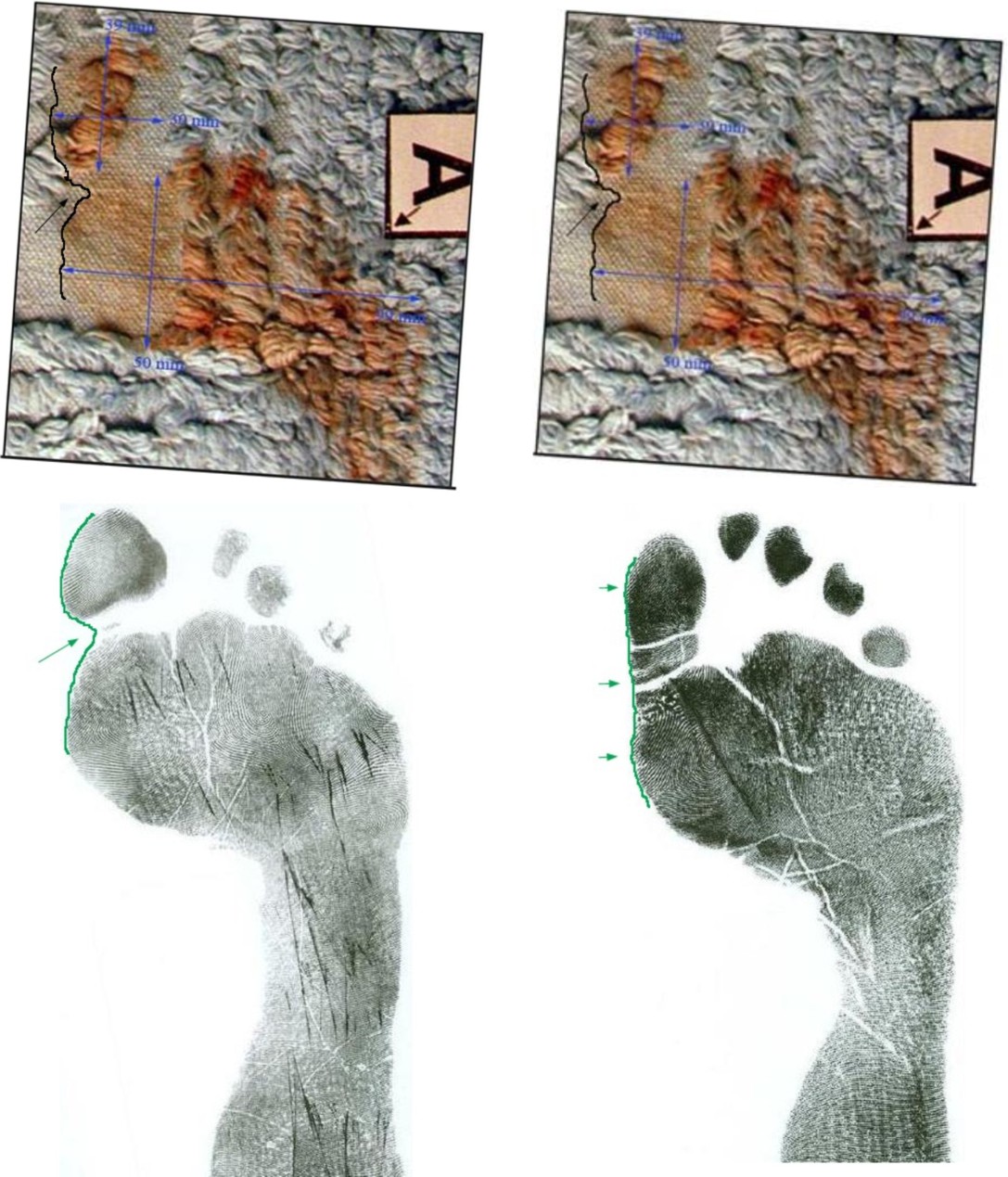
The “cleft” on the left side
This has a correspondence with one sample print, not so with the other.
29 . Table of metric comparison (by SomeAlibi)
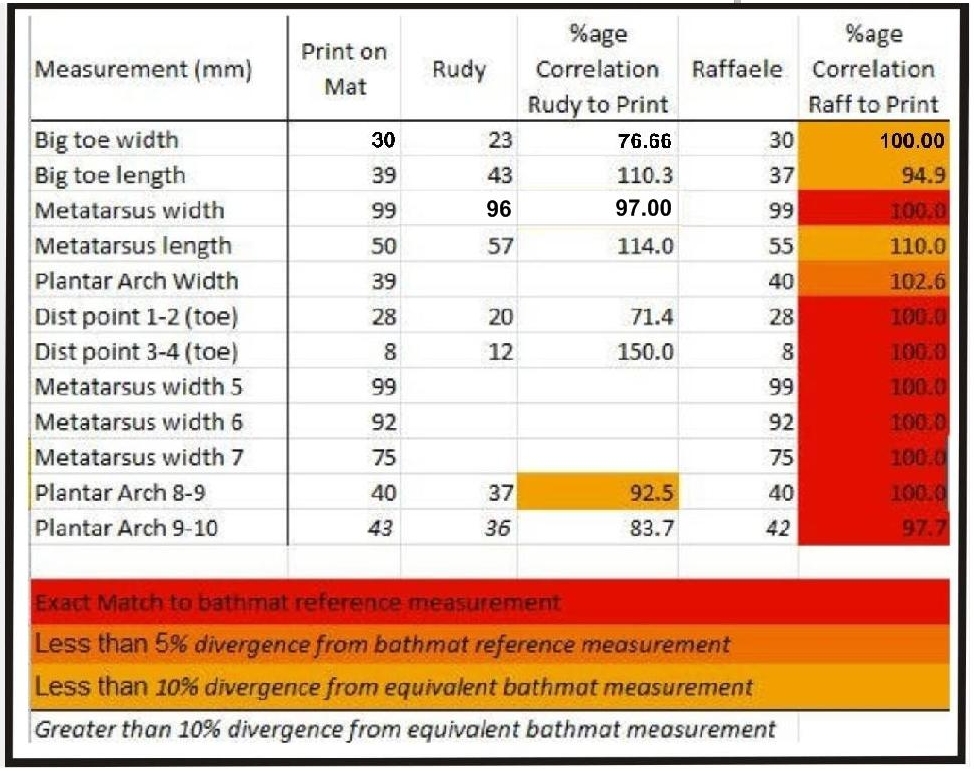
SomeAlibi’s post of a year ago
Comparison of measurements and analysis of correspondence degree of bathmat print, with both Guede’s and Sollecito’s sample prints.
Monday, February 03, 2014
Authors Of “Math On Trial” Bring The Explanations Of The Hard DNA Evidence Up To Date
Posted by Peter Quennell
The important new book in question Math On Trial is by mathematicians Leila Schneps and Coralie Colmez who is Leila’s daughter.
This article by Leila Schneps appeared in yesterday’s edition of The Independent and explains why the Nencini court has not ruled out any of the DNA evidence.
It’s not right to say there is “˜no evidence’ in the case against Amanda Knox. There’s plenty
The DNA alone is enough to raise questions
The verdict handed down yesterday at the new appeal trial for Amanda Knox and her former Italian boyfriend, Raffaele Sollecito, accused of the murder of British citizen Meredith Kercher in Italy in November 2007, may come as a surprise to those whose view of the case has been affected by an international media blitz based on the oft-repeated claim “There is no evidence”. Many believe that Rudy Guede, convicted in October 2008 for participating in the murder, acted alone.
There is, however, copious evidence to consider: the DNA alone is enough to raise questions. Leaving aside much of it, let’s focus for a moment on three key pieces of DNA evidence and present them from both sides, just as the jury may have heard them spoken of in court.First ““ the bra clasp.
The part of the victim’s bra containing the hooks had been ripped or slashed from the rest of her bra. Not immediately collected on that first day after the murder, it remained in the room in a sealed house for six weeks before being sent to the lab in December. There, it was tested and found to contain a large sample of Meredith’s DNA, together with a smaller but clearly visible contribution from Sollecito. The defence objections: firstly, between the two searches, objects in the crime room had been moved around, and indeed the bra clasp was found about a metre away from its original position.
Secondly, apart from “˜alleles’ - genetic traces - of Meredith and Sollecito on the clasp, there were a few unidentifiable extra ones. Putting these two facts together, the defence pointed out that Sollecito’s DNA on the bra clasp could have been a consequence of a careless police technician stepping on Sollecito’s DNA elsewhere in the flat and then entering the room and stepping on the bra clasp, even though no DNA of Sollecito was found anywhere else in the house except on a single cigarette butt in the ashtray.
Second ““ the mixed stain.
Although not visible to the naked eye, the chemical Luminol which flashes blue on contact with blood revealed a spot in the room of the flatmate whose window had been smashed and room rifled. Swabbing the spot produced a mixture of Amanda and Meredith’s DNA. This is a clear proof that the murderer entered that bedroom after the murder, as someone must have brought Meredith’s blood into the room, contradicting the defence theory that Rudy Guede broke into the house and then committed the murder.
The usual defence explanation for mixed DNA stains in the bathroom and corridor, namely that the house would have been coated in Amanda’s DNA given that she lived there, does not necessarily apply to a flatmate’s bedroom. It is much harder to leave traces of DNA than is commonly conceived, and hardly any of Amanda’s DNA was found in her own room - where she surely spent a lot more time than in her flatmate’s.
Lastly ““ the knife.
Days after the murder, a large kitchen knife was seized in Raffaele’s flat, where Meredith had never set foot. Police geneticist, Patrizia Stefanoni, swabbed spots on the blade of the knife and on the handle in the knife’s first DNA Test. One spot in particular attracted her attention: a visible scratch on the flat of the blade. The swab taken from this scratch yielded a positive ID for Meredith Kercher.
By the third trial, when a new attempt was made to collect DNA from the knife (which had been swabbed again during the appeal trial, though no tests were then conducted) there was no match to Meredith ““ a result welcomed by Knox’s defence team, though it did not in fact impact on the findings of the first trial.
Stefanoni’s test ““ she only conducted the first - came under strong fire in the courtroom. Two independent expert witnesses called in for the appeal against Knox and Sollecito’s original 2009 conviction stated that she had not worked in conformity with standard international protocol. Indeed, standard protocol for DNA testing involves three steps: first determining how much DNA is in a sample, secondly amplification, which reproduces the sample millions of times, and thirdly electrophoresis which produces the familiar DNA graphs showing peaks in the location of an individual’s alleles. Under cross-examination, Stefanoni explained that quantification had given a result of “too low” as the machine she used that day was not the most sensitive one in the lab.
Knowing that samples undetectable by the machine can still be sufficient to yield positive results, she chose to continue with testing. At the second stage of testing, amplification, a sample will normally be split into two or more pieces in order to run independent tests. But knowing that the sample was small, Stefanoni feared that cutting it in two would yield no result at all, and chose to amplify the entire sample in one unrepeatable test. The end result was a perfect match to Meredith Kercher.
Knox’s supporters have claimed since the beginning that the accusations levied against her are based on the Italian justice system’s hatred of a pretty, American girl who likes parties and having sex. And whilst both parties protest their innocence , Thursday’s decision shows that there is real evidence against her and Sollecito, that cannot be ignored.
Wednesday, January 29, 2014
Continuing Enormous Strength Of The Evidence Which Defenses Seem To Have Abysmally Failed To Shake
Posted by Our Main Posters

[Above Judge Massei at Meredith’s house with panel-of-judges members early 2009]
What this Florence appeal is REALLY about
There is much confusion on this, sowed by various at-distance commentators who don’t read the Italian press or the excellent English-language reporters right there on the spot.
This is NOT a re-trial. This is a FIRST appeal by Sollecito and Knox against the guilty verdicts and sentences Judge Massei awarded them late in 2009. It is being repeated since their defense teams helped to bend the first (Hellmann court) iteration of the first appeal two years ago.
Since the end of 2009 they have been provisionally guilty of murder and other crimes, subject to final ratification by the Supreme Court, which has not yet occurred. Judge Hellmann decided to let them out and travel worldwide. Many think his decision on this was legally weak.
Was there prime-face justification for this appeal?
Under US and UK law many lawyers and judges think the judicial process could have stopped right there in the US and UK, because the grounds for appeal the defenses came up with in 2010 were essentially innuendo about DNA and little else.
But the pro-defendant Italian system unlike almost any other in the world allows appeals if any are filed to automatically go forward. So the bent, stretched-out and illegally wide-scope Hellmann appeal of 2011 was the first result.
Appointed apparently in illegal circumstances to replace the highly-qualified Judge Chiari (the lead-judge for criminal appeals, who then resigned) Judge Hellmann was ill-qualified at best - he was not a criminal judge and had handled only one other murder trial before, which he got wrong.
The annulment of the first first-appeal
The Supreme Court very rarely completely annuls any trial or appeal. But in this case in March 2013 it did just that, on a large number of grounds.
The 2013-2014 Nencini appeal court in Florence starts with the early-2010 Massei report plus new guidelines from the Supreme Court. Nothing else floated since early 2010 counts.
This case seems to break all records ever for (1) defamatory and dishonest PR; (2) dirty tricks, many illegal, by the defense; (3) dishonesty by those accused in two defamatory books and multiple statements to the press; and (4) greed and blood money while the process still goes on.
Contempt of court trials and investigations have commenced to push back, Amanda Knox is particularly at risk because her book contains false accusations of crimes (again) and she defies the Supreme Court in not paying Mr Lumumba his damages though she destroyed his business.
Suggested Reading: Part One
Sooner or later (no necessarily now) read all the must-read posts in this group here, all the open questions for Sollecito in this group here, and all the open questions for Amanda Knox in this group here.
1. Getting up to speed on the 2008 RS and AK charges
Our four-part summary of Judge Micheli’s report is the best thing to read (scroll down) especially Micheli’s argument that ONLY Knox had any reason to re-arrange the crime scene - she lived there and needed to point evidence away from herself.
Also read Amanda Knox’s and Raffaele Sollecito’s many mutually contradictory attempts to provide one alibi for both.
2. Getting up to speed on the 2009 RS and AK trial
The prosecution performed brilliantly and left the defenses despondent and out-classed (paving the way for more dirty tricks in 2010-13) and we were told that two defense lawyers nearly walked off.
To get a flavor of how badly the defenses did, read this post and this post on Knox’s absolutely disastrous stint on the stand. From there the defense portion of the trial really went downhill.
To get a flavor of how well the prosecution did read about the damning reconstruction (known about in all of Italy but not widely elsewhere) described here and here.
3. Getting up to speed on the Massei 2010 Report
The most vital read of all is the short-form version of the Massei Report by Skeptical Bystander and a team on PMF dot Org. If you have no time to read any posts, make sure to read that.
The other vital reads, not here but on the new “The Murder Of Meredith Kercher Wiki”, are the overview of the evidence and the chart of evidence synopsis.
We had a large number of posts starting in 2010 checking out whether in all details the Massei Report got it right. Read this first take.
4. Getting up to speed on the crime-scene scenario
Vital to understanding the Massei court’s crime-scene scenario which Prosecutor Crini espouses, wade through this excellent reconstruction of the crime in a long Powerpoint by our lawyer James Raper with the Powerpoint whizz Kermit.
About Part Two
The next part of our most-recommended reading from 2010 to 2014 will follow after the verdict to help correct the ill-informed debate over whether Knox goes back to jail.
It hardens the case and in our view leaves no holes for RS and AK to wiggle through. We will point the post to those arguments that anyone tries to raise.
Tuesday, January 28, 2014
Strong Proof That Raffaele Sollecito Also Stabbed Meredith Kercher Causing The Lesser Wound.
Posted by Ergon
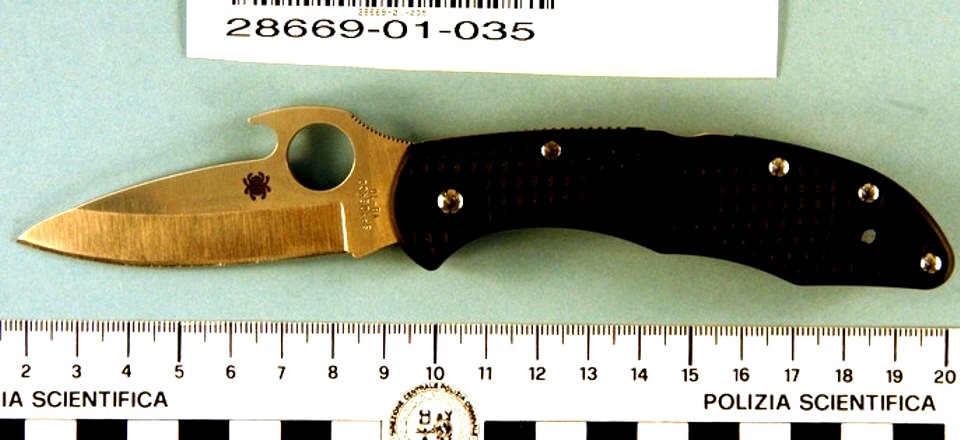
Sollecito’s “pocket knife” is a Spiderco Delica4 Emerson Opener made for killing people
Overview
This picks up from from my previous post just below on the large knife that overwhelming evidence shows was wielded by Amanda Knox.
Sometime around Thursday, January 30, 2014, Judge Nencini of the Florence Appeals Court will be delivering the verdict of the court in the case of Amanda Knox and Raffaele Sollecito, at which time all arguments regarding the knives, staged burglary, DNA and forensics, false accusation, wonky alibis, and reliability of witnesses will be rendered moot.
There will be nothing left but an argument about the legality of the process, and not the evidence, presented by the defenses if they choose to at some point in the fall of 2014 before Cassazione, the Supreme Court in Rome.
But, until then, we are left with the indelible image of Raffaele Sollecito’s defense attorney Giulia Bongiorno a few days ago flailing with two knives in court, arguing (1) the kitchen knife doesn’t fit the major wound, and (2) there’s a missing knife, which she suggested was a pocket knife wielded by Rudy Guede.
In part I, I proved that the imprint of the knife on the mattress sheet matched the kitchen knife, in shape and dimensions. We have already seen in other articles here on TJMK, that there is a definitive match with Knox and Meredith Kercher’s DNA on the murder weapon, and now we know it was transported to the cottage, to leave its mirror image on the bed.
Here, in part II, is a recap of Massei on the knives and wounds inflicted on Meredith Kercher, and how the defense continually tried to divert us away from the knife image by saying it did not fit the dimensions of the major wound.
Also we will have Frank Sfarzo and Bruce Fischer’s amateurish attempts to prove that Rudy Guede caused the knife wounds. And it will try to address what happened to the missing knife that inflicted the lesser wound on Meredith, and who might have wielded it.

Closeup of the stabbing end of the Spiderco knife shown at the top
Deliberate false claims
One of the many myths surrounding this case was that investigators had no reason to seize the kitchen knife from Sollecito’s flat, and when I showed the photos from Conti’s lab, with the deep scratches on it, that it may have been altered in some way, and denying that was where some of Meredith’s DNA might have been trapped. IIP even posted an out of focus picture some time back to prove that point.
Here is Frank Sforza on the late and unlamented Perugia Shock.‘ANY KNIFE COULD HAVE DONE THAT WOUND’
End of a Myth
Frank Sfarzo, Sept. 19, 2009
Quote: “It was introduced in the room, it was taken out of the box with all precautions, it was shown to them like a relic. They could have a look at it from a distance, and see, or believe to have seen, the groove into which the biological material of Meredith was found.” And:
“Amanda Knox’s lawyer Carlo Dalla Vedova brought him (independent expert Professor Cingolani) to say something very clear about the main one: any single-edge knife is compatible with Meredith’s larger wound.”
Here is Bruce Fischer on the error-ridden Injustice In Perugia.
Quote: “The knife was a common kitchen knife retrieved from the kitchen of Raffaele Sollecito. The knife was chosen from the drawer because it looked clean. (Editorial note: it was also, deeply scratched and nicked)
No blood was on the blade.
No DNA was on the blade.
The knife doesn’t match most of the wounds on Meredith.
The knife doesn’t match the bloody imprint left on the bed.
The photographic evidence shows that Raffaele’s kitchen knife is to (sic) large to match the bloody imprint on the bed.
At 4 cm from the tip the knife blade is 2.2 cm wide, while the injury (i.e. the small wound) is 1.5 cm wide. Raffaele’s kitchen knife could not have caused the wounds. The knife blade is also too long to have inflicted the large wound.” (Ed. note: Here they are conflating the dimensions of the lesser wound with the knife that inflicted the major wound, to cause confusion)
This is typical of the dishonesty of Bruce Fischer, who was only parroting what the defense experts had been saying in Massei’s court.
Fischer’s source was these posts from the now discredited Frank Sfarzo: Knife doesn’t match wounds and Knife doesn’t match imprint on bed.
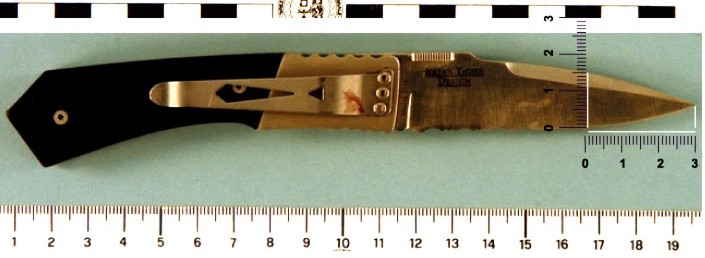
An image of Sollecito’s 2004 model Brian Tighe knife specifically made for killing people
From the Massei Report
This is from the excellent PMF translation.
P. 99: The witness (investigator) recognized it when shown Exhibit 36 as that same knife (pages 176 and 177, hearing on February 28, 2009). He remembered that in the drawer there were other knives, but he collected what was later indicated as Exhibit 36. It had the following dimensions: blade 17 cm. and handle of dark colour 14 cm. He recalled that in Sollecito’s bedroom they found another knife whose total length was 18cm, with an 8cm. blade.” (This would be his Brian Tighe pocket knife, the Spyderco flick knife was seized from his person when he was arrested)
P.135: The stab wound corresponding to the injuries on the right side of the neck was indicated as being a little wound of very small dimensions with a very small path. The path of the wound is 4cm long and only 1.5cm wide. The blade used to make this wound must have had a width of 1.5cm at 4cm from the point. This blade only entered 4cm into the neck “because it encountered the angle of the jaw” (page 33 of the transcripts).
P.147: Professor Vinci testified at the hearing of August 18, 2009. He considered the subject of the “bloody stains” found on the undersheet in Meredith Kercher’s room. In relation to these stains, on the basis of graphics given in the report dated June 30, 2009, he asserted that the knifeprint found on the undersheet in Meredith’s bedroom could have been made either by an 11.3cm knife blade, or by a 9.6cm knife blade together with a mark 1.7cm long left by the handle of the same knife. In either case, the blade could not be wider than 1.3/1.4 cm. (Ahem)
P. 154: Prof Cingolani: He clarified that irregularities present on the blade, on the edge of the blade, could have created the rippling in the wounds.
P. 157: the examination of the wound on the right part of the neck, which had absolutely incompatible dimensions: 1.5cm long and 0.4cm wide with a depth of 4cm.
p.164: she was therefore struck on the right latero-cervical region with a single-edged blade which produced a wound with dimensions of 1.5cm by 0.4cm, with a penetrating depth of 4cm: an action not relevant in determining the cause of death but intended, as before, to subdue Meredith Kercher’s resistance.
p.166: the width of the (kitchen knife) proximal third [blade one third of the distance from the handle] is 3cm.
p166: Along the edge, there was evidence of irregularities in the form of thin ridges at 2.2cm and at 11.4cm from the tip.
p. 167: The experts and consultants who were examined during the course of the trial, taking into examination the various wounds present on the neck, excluded the compatibility of the knife Exhibit 36 and the wound inflicted on the right latero-cervical and having the following dimensions: 1.5cm by 0.4cm, with a depth of 4cm in an oblique upwards direction. They in fact showed that the confiscated knife, at a distance of 4cm from the tip, has a width of approximately 3cm and thus almost double the 1.5cm width of the wound, a width thus incompatible with the dimensions of the blade of this knife.
p.172-3: In relation to the above, the thesis of the incompatibility of the most serious wound and the knife Exhibit 36 is held to be unacceptable, though this knife is incompatible with the 4cm-deep wound, as we have seen. Nor does this conclusion contrast with the circumstances illustrated by Sollecito Defence consultant Professor Vinci in his report relating to the “šanalyses of the haematic stained shapes discovered on the mattress cover in Meredith Kercher’s room”›.
p.175: The reconstruction offered by Professor Vinci certainly appears suggestive. Some doubt remains in the reconstruction of the dimensions of the knife derived in relation from the marks found on the bed sheet. If these marks indeed derived from the knife placed on the bed sheet, then they should in fact have been more abundant, and should have outlined the shape of the knife with greater precision, for the following reason: the knife, if it was placed on the bed sheet, was placed there immediately after it had been used to strike Meredith; therefore, the fresh and abundant bloodstains present on the blade should have been imprinted onto the bed sheet in a more evident and copious way than is actually appreciable. It cannot in any case remain unobserved that, if one of the knives used had a blade length of 11.3cm, or else 9.6 cm ““ according to what was indicated by Professor Vinci in the conclusions to his report ““ the argumentation set forth to sustain the incompatibility of the knife Exhibit 36 would not, on this alone, have any foundation.”
For the record, here are the paragraphs from the English translation of the Massei Report where Patricia Stefanoni describes the streaks and scratches on the double DNA knife and locations where samples were taken.
Judge Massei (on pg. 196) wrote about forensic expert Patrizia Stefanoni:
“She specified that trace B had been taken from a point on the face of the blade; she added that no biological trace was visible to the naked eye. However [she added that] “under considerable lighting, a series of streaks were visible to the naked eye. These streaks ran parallel to the upper part of the blade, therefore, more or less, they were parallel to this side [of the blade] and towards the point they went downward and, therefore, they followed the shape of the point. These streaks, anomalies in the metal, were visible to the naked eye under intense lighting” (page 95 of the transcript). Still in regard to the visibility of these streaks, she specified that they were “visible under good lighting by changing the angle at which the light hit the blade, since obviously the blade reflects light and thus creates shadows, making imperfections visible”.
The samples taken from the handle, in the points indicated with the letters A, D, F were taken in order to verify the possible presence of DNA by the person who grasped that knife. In particular, for sample “A”, a particular point had been chosen, “in which there’s the hand-guard” (page 95) and therefore, in all likelihood, the point where there was the most friction between the hand that grasped the knife and the handle. This sample yielded the result of Amanda Knox’s genetic profile.
The other samples yielded negative results, except the one taken from the blade, from the “scratches and streaks visible under good lighting, by changing the angle of the lighting with regards to the blade” that yielded the genetic profile of the victim (page 96 hearing May 22, 2009).”
And now we know: Dottora Patrizia Stefanoni got it right.
And some disagreement amongst the experts: p.291-2: Professor Cingolani had in fact noted and declared the following: “in the second lesion, the one that is 2 centimetres deep and 1.5 centimetres wide from corner to corner, the only thing that we are tempted to do, [albeit] in an absolutely amateurish/unprofessional way, because we only have photographs available, is to measure, assuming that only the tip entered, how wide the blade is [at a point] 2 centimetres from its tip: it is precisely 1.5 centimetres wide!”

A closeup with measurements of Sollecito’s Brian Tighe knife made for killing people
My own investigation
Here is my initial close examination first posted on PMF dot Net last summer.
Ergon Post subject: INVESTIGATION OF THE KNIVES USED IN THE MURDER Posted: Sun Jun 09, 2013 12:42 am
Investigation into the death of Meredith Kercher-THE CAUSE OF DEATH AND THE MEANS BY WHICH IT WAS OCCASIONED
The murder of Meredith Kercher was particularly bloody and brutal. Reading through Massei, pages 109- SURVEY AND EVALUATION OF THE FORENSIC RESULTS through to 158-173, THE CAUSE OF DEATH AND THE MEANS BY WHICH IT WAS OCCASIONED we are reminded of the brutality with which the attack took place, the sexual assault by more than one person, the restraining, the defensive wounds on Meredith’s hands, the torture by more than one knife, restraining by a hand over the mouth when she screamed, (even while she bled to death) and two major knife wounds, one to the left of the throat, the other, to the right. Massei rightly concludes, as did the Supreme Court, that more than one attacker was involved, and, per Massei, there was more than one knife used in the attack. The defense experts tried to draw attention away from the kitchen knife, but, reading through Massei again, I saw how they dropped clues to what the dimensions of the second knife might have been.
We know that Raffaele Sollecito had a fetish for violent porn, that he had an expensive collection of knives, and his many alibis for the night in question have been thrown out by the court. From my studies of criminal psychology, from reading both Amanda and Raffaele’s books and watching videos of their court appearances and television interviews, their psychopathology seem apparent not only to my eyes, but even to the general public that must have looked at them and decided their story somehow did not ring true, and refused to buy their books. There are indeed certain neurological deficits apparent in their demeanor that renowned German neurologist Dr. Gerhard Roth postulates shows up as a ‘dark patch’ in brain scans of all those who display criminal behaviour, and even, “The second type is the mentally disturbed criminal who looks at his world as threatening. A wrong look, one false move, he can explode and become a killer,” he said.
I was shown videos of the crime scene, and able to observe the wounds in Meredith’s neck. The scenes of the room in which the murder took place and, the neck wound, were truly horrifying to me, and showed the extent of the attack. Those images still sit in the mind, but also, cause me to want to get to the bottom of this mystery, hence, my work on the case.
I believe, observing the photos I already posted in the Evidence Files that the kitchen knife was the murder weapon that struck the fatal blow that night. I also believe, reading the pathologist’s report, that the blade that was stuck in Meredith’s neck, in the right latero-cervical area to a depth of 4 cms, was Raffaele Sollecito’s Brian Tighe pocket knife, photo also in the evidence files. Yes, no DNA or blood was sampled from it, but that only indicates it was successfully cleaned that night. My reading of Sollecito’s pathology is that he would not want to dispose of the knife he used, it being very expensive and also as an extension of his fetishistic ego. One other thing I asked to look at: The high resolution photos I posted of the bed show the outline and dimensions of two knives. I believe that both images are of the kitchen knife that struck Meredith in the left latero-cervical to cause a cut of 8-9 cms in depth, and a length of 8 cms (p. 167)
There are two exhibits of the mattress cover, one marked “J” and the other, “O”, both displaying the approximate size and dimensions of the kitchen knife, which I will explain when I post the photos. The first, “J”, has more blood because I believe the knife was placed there first and wicked on to the sheet, causing the distorted splotch at the end. By the time it was moved to its final position by the purse, “O”, it retained just enough blood to leave a clearer, indelible impression.
It was a butchery.”
One last point: Rep. 33A/B/C/D were four samples taken from a black-handled folding knife. It tested negative for blood, but, in one sample, the DNA profile matched a mix of Knox and Sollecito. The other samples were negative. Stefanoni: pp. 103-104
Looking at the images produced by my illustrator, and taking the average of the two estimates of the wound depth, 2 and 4 cms, one arrives at a blade width of 1.5 cms at 3 cms length from the tip of Raphaele Sollecito’s Brian Tighe collectors knife, on which, coincidentally, both Amanda Knox and Sollecito’s DNA was found.
Conclusion:
Raffaele Sollecito stabbed Meredith Kercher, causing the lesser wound. And my personal opinion? It was with the Brian Tighe knife, and somehow both he and Amanda Knox got their DNA on it around the same time that night.
Monday, January 27, 2014
An Investigation Into The Large Knife Provides Further Proof That This Was THE Knife
Posted by Ergon
Overview
This is the first report of an investigation (the second part follows soon) of the kitchen knife used in the murder of Meredith Kercher, RIP.
Specifically its compatibility with the imprint of a bloody knife found by police investigators on her bed under-sheet which as you will see here seems possible to prove.
Two other recent posts also concentrated on aspects of the knife as strong proof: (1) proof of both Knox and Kercher DNA and (2) proof from the throat wounds.
- Reference files are from very high definition crime scene photos not in general circulation.
- Grateful thanks to the volunteers of the Meredith Kercher community who assisted in this production
Florence Court of Appeals
This is our poster Machiavelli, tweeting from the Florence courtroom on November 26, 2013:
“(Prosecutor Alessandro) Crini stated that this kitchen knife was compatible with the knife print on Meredith’s bed sheet”.
And this is from the defense summing up on January 09, 2014:
Bongiorno: “It’s too big, not the murder weapon.”
“Bongiorno shows a picture with an envisioned “knife” (pocket knife belonging to Guede?) together with the print on the bed sheet.”
“Nobody brings a “small blow with a big knife” “You don’t use half of a big knife” (she says)
Genesis of an investigation:
To recap: evidence was been presented at the Massei court of the first instance, which accepted that the kitchen knife, containing both Meredith Kercher’s DNA on the blade (trace B) and Amanda Knox’s DNA on the handle (trace A) was the weapon that struck the fatal blow to Meredith Kercher’s throat.
At some point after the attack, the perpetrator, Amanda Knox, puts it down on the bed, leaving “hematic stains” (bloody imprints) on the mattress.
The court concludes the shape of the imprints are compatible with the kitchen knife. It also concludes, based on the size of a lesser wound that a second, smaller knife caused the wound on the other side of the neck, and, the impossibility of accepting that a single weapon inflicted both wounds.
This is what it boils down to now, as we come to the final arguments of this case on January 30, with a decision to be handed down by the court later in the day:
- Was the kitchen knife found in Raffaele Sollecito’s kitchen the murder weapon that killed Meredith Kercher on November 01, 2007?
- Did the killer leave behind proof in the form of bloody imprints on the under sheet covering Meredith’s bed?
- And is the defense trying to divert attention away from it, even though the image on the bed fits the dimensions of the kitchen knife?
- And pointing to a second knife, not ever found?
This article (to be followed by part II) was prepared to offer answers to these questions.
Methods used
As someone with a keen interest in photography, I know we see things in photographs that are not always apparent to the naked eye.
Where before we had all been misled by low definition photographs released by the defense to obscure incriminating details, I was able to obtain and view the high definition photographs shown here that proved that indeed, the bed imprints matched the seized kitchen knife, exhibit 36.
These photographs, first posted at Perugia Murder File Evidence Files have been circulating for some time, with members trying to match the knife to the bed imprints, but not, in my opinion, being able to match it exactly.
First, note that the killer placed a knife on two separate locations on the bed, marked by reference cards “J”, and “O”. (Reference photos below.)
I discarded “J”, because there was too much blood there to form an accurate measurement. The killer lifted the knife and then placed it at “O”, which gave a better image, but even then, did not match exactly. Still, it was clear the images looked like a kitchen, and not, a pocket knife as alleged by the defense.
Looking at the reference photo, I saw a double image of a knife blade at “O”. (see where there’s a curved edge of the blade? That’s what convinced me there might be a double image there)
Conclusion reached
My opinion is the knife shifted slightly when it was placed there, hence the double image, which now made a perfect match with the kitchen knife, in both instances (see reference photos).
So I got a professional illustrator and other skilled people people to do the scale drawings and produce the video you see above which seems to provide conclusive proof the murder knife was placed on the bed.
Reference photos:
Image 1 above (click for larger image): Bed II (Image J and O on under sheet, shot November 02, 2007)
Image 2 above (click for larger image): Knife II (Image O on under sheet, shot November 02, 2007)
Image 3 above (click for larger image): FOTO5BIS (Conti-Vecchiotti lab, Mar. 22, 2011)
Image 4 above (click for larger image): Knife-Bed-Vector-AllScales (To prove the scales used to match the images)
Image 5 above (click for larger image): Knife-pos-lower-hi (The knife’s first resting position at “O”)
Image 6 above (click for larger image): Knife-pos-upper-hi (The knife’s final resting position at “O”)
Next steps
There are only four more days left till the Florence Appeals Court under Judge Nencini issues its verdict. It must of course consider ALL the evidence, of which there is a preponderance that indeed suggests the verdict will, as would be proper, be guilty as charged.
Part II will be ready ASAP. It will be a recap of Massei on the knife, and how the defense continually tried to divert us away from the knife image by saying it did not fit the dimensions of the major wound. Also will have Frank Sfarzo’s misdirection and Bruce Fischer’s amateurish attempts to prove that Rudy Guede caused the knife wounds.
Happy as always to do my share for justice for Meredith Kercher.
Monday, November 25, 2013
Appeal Session #4: Today Lead Prosecutor Alessandro Crini Summarises The Prosecution’s Case
Posted by Our Main Posters
Overview
This is the report on the first day of Prosecutor Crnini summarizing the entire case.
This was not attempted at such length at the 2011 Hellman appeal and that panel of judges was perhaps not ever fully in the picture. The second day of the presentation is reported on here.
Real-Time Reporting, Bottom-Up
5. Good reporting on the court today
Andrea Vogt has posted an objective report here and Barbie Nadeau an objective report here. We will post excerpts from both and other sources after the appeal session on Tuesday is done.
5. Warning about AP’s Colleen Barry
The Associated Press’s Colleen Barry is once again filing highly biased reports from the court. This is an appeal by Knox and Sollecito AGAINST a guilty verdict (by Judge Massei) and not an appeal by the prosecution to “reinstate” a guilty verdict. Get a grip.
4. Final post from the court today
It is 5:30 pm in Italy. Judge Nencini has declared today’s session at an end and he has allowed the prosecution to resume its presentation tomorrow. Prosecutor Crini has about 1/3 of his presentation on the evidence still to come.
3. Tweets from main poster Yummi
Yummi has warned us that the wireless internet bandwidth inside and just outside the courtroom gets overloaded late in the day as the reporters get busy on their reports. Yummi does have a way around this but it involves leaving the courtroom when key arguments might be made and walking some distance away. So there might be some slight delays.
[More pending; Dr Crini has alerted that his presentation will be in 16 chapters]
51. [Judge] Nencini suggests to interrupt and go on tomorrow with following prosecution’s points. New schedule.
50. Chapter 11. is DNA. Crini says we may have evidence enough by now anyway
49. Crini censures Hellmann-Zanetti’s reasoning about calunnia (why not indicate the real culprit?). Says H-Z committed ‘physical violence’ on trial file
48. Knox’s calunnia is a strategy protracted over time says Crini
47. Dreamlike component in Knox’s statement, fish blood, are devices needed to surround a calunnia strategy
46. Knox needed to put some additional content into the ‘calunnia’, says Crini, or wouldn’t be believed, so she puts in pieces of truth
45. Knox spoke about a scream an a sexual violence before anyone knew. Sollecito said nothing was stolen before they knew.
44. Points out Sollecito says Romanelli’s door was wide open; Knox doesn’t notice theft. Crini highlights the ‘combination’ of inconsistencies
43. Knox thinks locked door is normal; does not flush toilet when finds feces; does not notice blood before having a shower; thinks blood is ok
42. Notes Knox’s statements are inconsistent and ommisive before her interrogation.
41. Crini speaks about Knox’s declarations. Interested in the timings. Says too much was repeated to be coerced.
40. Crini speaks about chapter 9, the statements of Sollecito. His call to her sister. His alert was late but even so preceded the postals arrive
39. Bathmat print and luminol prints were chapter 7. of Crini’s argument; 8. is the staging of theft.
38. The most significant stain may be the one in Romanelli’s room, says Crini.
37. Speaking of a female’s print left in luminol, Crini sounds outraged, saying other substances is vague unsubstantiated conjecture [eg it was blood not bleach]
36. Guede’s sentencing was not well calibrated says Crini. But a Guede alone scenario is not tenable
35. Does it make sense for Guede to leave there the evidence of (putative) theft, and clean footprints?
34. The unitary sense made by elements like the bloody print, is a cleanup. Considers the lone-perp scenario: inconsistent
33. Crini: starts talking about the isolated bloody print; calls it a ‘talking element’. Why is that print alone?
32. Suspects are only ones with a ‘logistic’ capability and an interest to ‘clean’ the murder scene. They aimed at ‘diminishing’ the evidence mass
31. Knox’s lamp was the only light in her room.
30. Crini: the perp(s) organized a rather complex plan to clean up and ‘sidetrack’ at the murder scene.
29. Still to be determined if calunnia was “occasional” due to pressure, or “aggravated” [sidetracking]; Crini saya a ‘depistaggio reale’ (sidetracking) occurred
28. Crini: suspects’ statements are extremely interesting: RS’s statements; AK’s e-mail, internet statements, [Knox’s] memoriale
27. Crini: a most fertile chapter of analysis is the ‘post-factum’ actions and behaviors of defendants
26. Crini has unfolded five chapters. Says he has a total of sixteen
25. Quintavalle, details of his testimony and woman’s description are exceptional indicators of accuracy.
34. Crini: it is unlikely that Quintavalle got it wrong. Because of contextual elements.
23. It is incorrect to dismiss a witness a priori because late. But for reasons totally different. Sometimes late is symptom of reliability.
22. Wants to deal with the issue of the fact that he came forward late, urged by an acquaintance
21. Crini: fifth argument is Quintavalle. He says he is sure about his testimony. Is a different kind of witness
20. Crini accepts both alternatives on time of death, after 23.15 or before 22.30 (but seems to prefer the earlier one)
19. Crini: Do not overestimate importance of timings that are not anchored accurately or cannot be proven
18. Crini: timeline is marginal to the case. All unproven timings to be taken cautiously.
17. Crini starts fourth theme: timings. Says they are very vague, except the tow truck
16. Crini: Curatolo is no ‘super-witness’, but can contribute to helping the court to draw their scenario
15. Curatolo saw a couple discussing and this memory is very specific, peculiar
14. Curatolo did not confuse night with Halloween, because it was big party in piazza the previous night, and because it did not rain
13. Crini: the court saw Aviello, shows what top [level] of unreliability is; the SC suspected so unreliable that calunnia elements had to be assessed
12. Crini: many trials could not exist if drug addicted testimonies were dismissed
11. Crini: the H-Z court assessed Curatolo a priori based on him as a person, stemming from questions of the court itself
10. Crini about Curatolo, describes Piazza Grimana; he was an habitual presence of the piazza, proven reliable in other cases
9. Crini: computer records and alibi point to Sollecito being not at home but on murder scene
8. Crini cites the log files of Fastweb: no internet activity, only automatic connections.
7. Crini: failure of computer alibi is evidence against, not just lack of confirmation.
6. Nencini notes prosecution did not ask to interrogate Sollecito. Crini cites D’Ambrosio’s computer expert report. No interaction before 5am
5. Sollecito gave computer alibi days later, and words his statement in the singular form.
4. Crini: first theme he deals with is presence of crime scene; alibi, if it’s false it is evidence no matter why false (cite from Guede trial)
3. Crini attacks the method of logic reasoning of annulled appeal: parceling out evidence, parrots aspects of civil procedure
2. Crini: Supreme Court censure was against the foundations of appeal , all parts not just some errors; appeal was ‘razed to ground’.
1. Crini: this appeal is unusual, not because of the case but for the course followed. Usually appeals are narrow, this SC annulment is not.
2. Tweets by Andrea Vogt
3. At Crini’s side in amandaknox appeal today is veteran Florentine prosecutor Tindari Baglione. Before this, he was in Cassazione.
2. Prosecutor Crini in Florence: don’t repeat error of Perugia appeal. Consider evidence wholly, including Curatolo.
1. Will prosecutors ask life sentences in amandaknox appeal today? Will Sollecito’s presence in court benefit him? Verdict January 10.
1. Prosecution Begins
This is the prosecution’s day. Sollecito is reported as being in court but low-key.
Various reporting notes the significant presence of Dr Tindari Baglione, formerly with the Supreme Court, about whom we posted on in September as follows:
The new Prosecutor General of Tuscany (Florence’s region) Dr Tindari Baglione, the chief prosecutor of Tuscany’s appeal court, is selecting the prosecutors for the appeal. He arrived in Florence in May of this year. He is said to be formidably unbending. He recently imposed tough sentences on 27 people for the environmental damage caused by illegal work in Mugello on the high speed rail link between Florence and Bologna.
Tuesday, November 12, 2013
Differences Between Micheli, Massei, Hellmann and Nencini Courts Pointing To Almost Certain Outcome
Posted by Peter Quennell

What are the biggest differences? In fact the Supreme Court already pointed them out: science, scope, and balance.
Judge Micheli, Judge Massei and Judge Nencini all have a very extensive criminal-case background. All three have handled many cases of murder, many cases against the mafia, and many cases involving criminal science. All three have remarkable success records and have hardly ever been overturned on appeal.
Judge Hellmann and his court are the extreme outliers. Until forced into early retirement by the Council of Magistrates, he had been a (quite good) business judge. His one major criminal case, years ago, had led to a farcical outcome, and he was ridiculed for this at the time.
Cassation made it very clear that he simply did not reflect a knowledge of the precise Italian law on scope and balance at the appeal level, and that he mishandled the science. In fact, as he actually said, the reason he appointed two independent DNA consultants was that he was at sea on the science.
That left Judge Hellmann’s panel of judges like a rudderless ship, bereft of the kind of good guidance from the lead judge on science, scope, and balance that comes only from many years of experience.
Which, given a level playing field, the pathbreaking Italian system enforces competently like almost no other.
Above all as the Hellmann Report makes extraordinarily plain, his court came to be swayed by the CSI Effect, with the help of two tainted consultants and probably the irresponsible Greg Hampikian in Idaho.
The CSI Effect is a phenomenon very, very unlikely to happen in Judge Nencini’s court. First, take a look at this good explanation of what the CSI Effect is in the Fox Kansas City video.
Many crime shows such as the BBC mysteries and the Law & Order series and spinoffs show investigators solving their crimes in the old-fashioned way. Lots of witness interviews and alibi and database checking, and walking around and loose ends and lying awake at night puzzling. And often there’s a big stroke of luck.
But if you watch the very popular CSI Las Vegas series and its spinoffs in Miami and New York, and the various clones on other networks, you will see something very different indeed.
When those shows first began airing worldwide in the late nineties, the producers explained that audiences increasingly appreciate learning something new when watching a show, and it is true, one sure can load up on the trivia.
But you will also see the US equivalent of Dr Stefanoni and her forensic team in those shows, roaming far beyond the narrow crime scene, interrogating witnesses and checking alibis and finding a lot of non-forensic evidence, and even at times drawing guns.
Most unreal is that, time and again, the forensic evidence testing is clearcut and takes just a few minutes and instantly clinches the case.
- There are several articles like this one and this one on whether the Casey Anthony jury was affected by a shortfall in the starkness of the forensics when the behavioral evidence seemed so strong.
- There are several articles like this one and this one on whether the appeal verdict outcome in Perugia might be affected in the same way.
- There are many articles like this one and this one and this one and especially this one saying there is a tough added burden on investigators and juries without a commensurate improved outcome.
With conviction rates declining in the US and Europe, professionals are taking a scientific look at whether the CSI Effect is one big cause of that decline.
At the macro level in the US this writer doubted that the CSI Effect is fatally unbalancing takes on the wider evidence. The same conclusion was reached in this first major study at the micro level.
But the belief in the CSI Effect continues. Articles like this one on an Australian site talk of a backlash against too many acquittals. Some articles like this one argue that maybe lay juries are out of their depths.
And judges and prosecutions are taking countermeasures.
In Ohio and many other states prosecutors and judges are acting against a possible CSI Effect in their selection and briefing of juries. And an NPR report came up with these findings.
Some states now allow lawyers to strike potential jurors based on their TV habits. Judges are issuing instructions that warn juries about expecting too much scientific evidence based on what they see on TV.
In the field, Shelton says death investigators sometimes run useless tests, just to show they went the extra CSI mile.
“They will perform scientific tests and present evidence of that to the jury. Even if the results don’t show guilt or innocence either way, just to show the jury that they did it.”
This is coming at a time when death investigators in America have no resources to spare. An investigation by NPR, PBS Frontline and ProPublica shows some states have already opted not to do autopsies on suicides, others don’t autopsy people who die in traffic accidents, and many don’t autopsy people who die over the age of 60.
But Murphy, the Clark County coroner, expects things to get worse.
“You know, we’re in budget cuts right now. Everybody’s in budget cuts. Las Vegas is no different than anybody else. We’re hurting. We’re going to feel that same crunch as everybody else,” he says.
One of Zuiker’s great disappointments is that, for all its popularity, his fictional Las Vegas crime lab didn’t generate more political support to fund death investigation.
“I’ve done my job. You know, we’ve launched three shows that cater to 73.8 million people a week and is a global phenomenon and the largest television franchise in history. We hoped that the show would raise awareness and get more funding into crime labs so people felt safe in their communities. And we’re still hoping that the government will catch up.”
None of the science in Meredith’s case has ever been discredited in court. Even in Judge Hellmann’s court the agenda-driven independent consultants Conti and Vecchiotti failed - and under cross-examination admitted it.
Also remember that the Hellmann court did not get to see two very key closed-court scientific presentations (the stark recreation of the attack on Meredith, in a day of testimony, and later in a 15 minute video) which had a very big balancing effect on the Massei court.
Right now the reputation of not one defense-campaign stooge who has attacked the science remains intact.
Greg Hampikian has headed for cover. He had widely proclaimed that he clinched the Hellmann court’s outcome, in an act which may well have been illegal. Unsurprisingly, he is now trying very hard to hide his own claimed “proof ” of shortfalls in the science, as Andrea Vogt has been showing in her Boise State University investigation, and as we will soon post more on.
Saul Kassin is another defense-campaign stooge who falsely claimed that he clinched the Hellmann court outcome by “proving” a false confession by Knox - in an interrogation that never even took place.
Despite all of this, maybe as straw-snatching, we can again see an organized attempt to confuse American opinion on the science of the case.
Whether she did this intentionally or not, that is what the PR tool Colleen Barry of the Associated Press was doing when she omitted that the trace of Meredith on the knife is undisputed hard evidence.
Judge Micheli and Judge Massei handled the science, scope, and balance with some brilliance. In all three dimensions Judge Hellmann fell short abysmally.
What is your own bet on the outcome under the exceptionally experienced Judge Nencini?
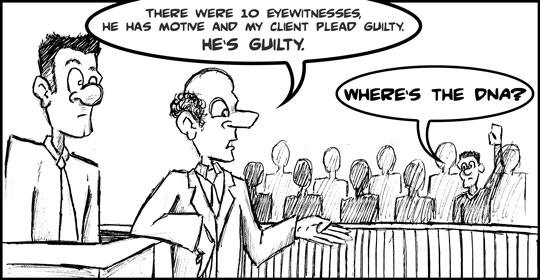
Parts of this post were first posted in 2011 after the disputed and much examined outcome of the Casey Anthony murder trial..
Sunday, November 10, 2013
The Crime-Scene Clean-Up: How Rudy Guede’s Diary Provides Even More Proof That It Happened
Posted by pat az
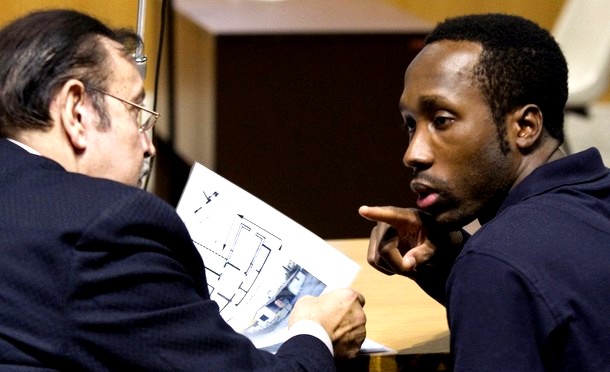
This post is crossposted from my own place. Here is one of my previous crime scene analyses on TJMK.
Rudy Guede was ultimately declared convicted by the Supreme Court in 2010 of participating in the 2007 murder of Meredith Kercher.
The prosecution claims the two other participants are Amanda Knox and Raffaele Sollecito. Knox and Sollecito are currently appealing their conviction of the same crime.
The case against the three of them involves a suspected clean up of the hallway in the apartment after the crime. Meredith’s blood was found in the bathroom, and half a footprint in her blood was found on the bathroom mat. However, there was no visible blood between Meredith’s bedroom and the bathroom.
The only visible blood in the hallway were faint partial shoe prints that led directly out the front door of the apartment.
After the murder was discovered, the media reported almost daily on developments in the case. The day of the murder, the press reported on the blood found in the bathroom and the bedroom.
But until police used luminol at the apartment on December 18th, the media didn’t report on any significant blood found in the hallway. Between November 2nd and December 18th, only one person stated that significant amounts of blood had been in the hallway.
Rudy Guede.
Rudy Guede actually wrote about it in his diary between Nov 20th and Dec 6th, after being captured in Germany.

The police arrived at the apartment on November 2nd. According to media reports, the blood they spotted immediately was only in the bathroom and Meredith’s bedroom. When the scene was more closely examined, after the discovery of the body, police found visible blood patterns on the floor left by Guede’s left shoe as he left the apartment.
None of the people who arrived in the apartment on the afternoon of November 2nd reported seeing them; these footprints are not in any of the stories of the events of Nov 2nd told by Amanda Knox nor Raffaele Sollecito. So, while these prints were visible, they were not substantially obvious.
On December 18th 2007 investigators applied Luminol in the hallway and other bedrooms. This forensic chemical is used to detect blood which has been cleaned away. The Luminol revealed several footprints in the hallway between the bedrooms of Knox and Meredith. Example below. Some of these footprints were leading towards Meredith’s door.
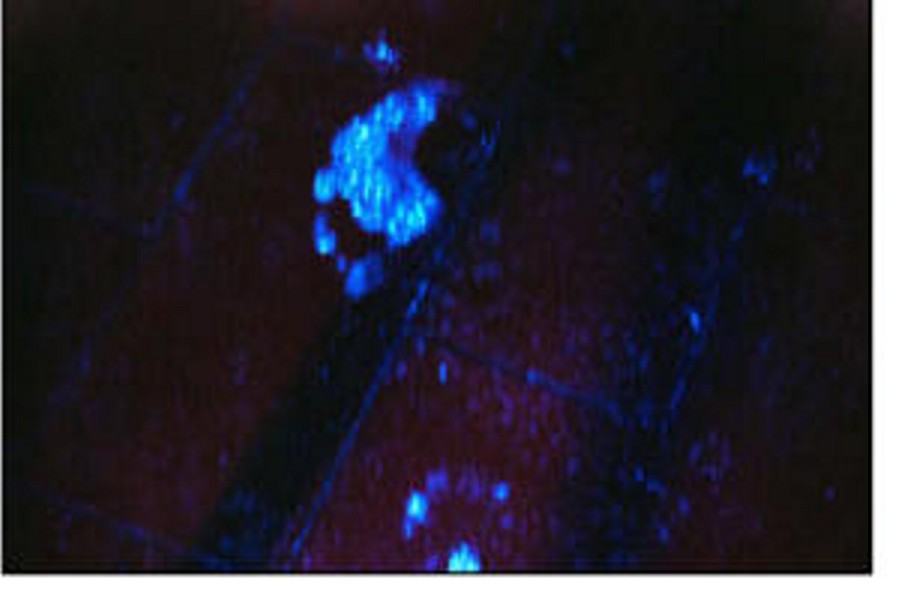
They also discovered prints in Filomena’s room which contained Meredith’s DNA and Amanda Knox’s DNA. They also revealed a footprint in Amanda Knox’s bedroom. (The defense unsuccessfully contested the investigator’s conclusions that these prints were made with blood).
On November 19 2007, an international arrest warrant was issued for Rudy Guede. He was arrested in Germany on November 20th. Guede remained in Germany until his extradition on December 3rd.
During his stay in jail in Germany, Guede wrote a long statement that was published and translated. Guede’s writings are similar to to Knox’s jail writings in many ways - they both try to write out their own detailed version of events, while pointing blame elsewhere.
But Guede’s comments may in fact be confirmation of a clean-up after the murder of Meredith Kercher (emphasis added):
I am asking myself how is it possible that Amanda could have slept in all that mess, and took a shower with all that blood in the bathroom and corridor? (Guede, Germany Diary, P21)
The police did not find evidence of any other blood until December 18th, AFTER Guede returned from Germany. As indicated above, the luminol revealed multiple footprints in the hallway, in Knox’s bedroom, and in Filomena’s bedroom. The image below shows these results in blue. Guede’s partial footprints are shown in red.
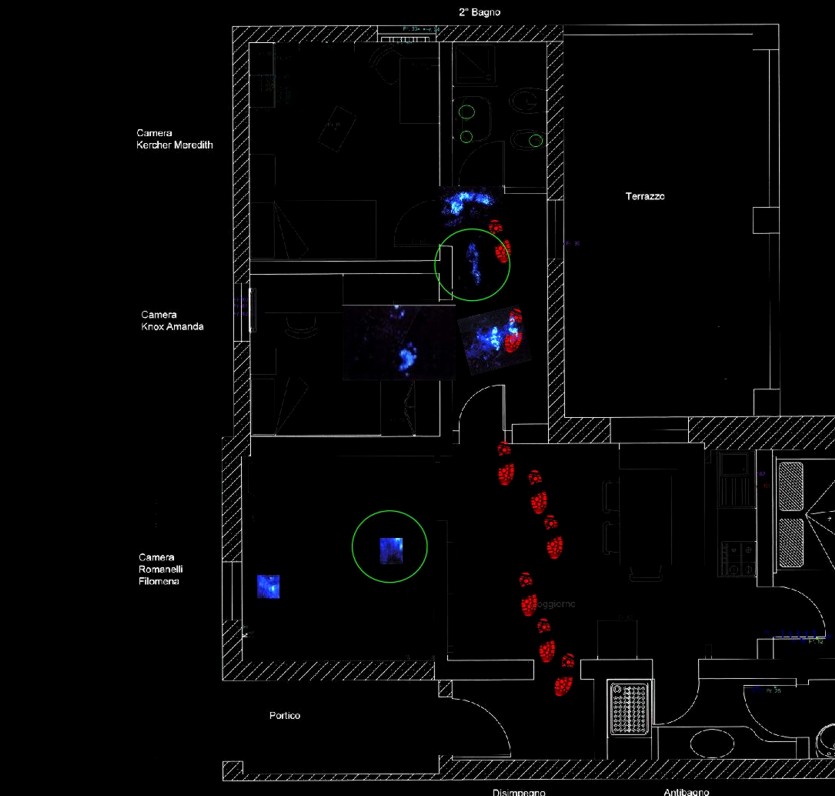
The conclusion is inescapable: Guede knew there would be significant evidence of blood in the hallway, before the police themselves found that evidence.
How did Guede know there would be more blood found in the hallway, before the police found that evidence on December 18th? And why wasn’t that blood there on the morning of November 2nd?
The courts believe the blood in the hallway was cleaned after the murder of Meredith Kercher. And the Micheli and Massei courts believed only one person had the motivation to hide this evidence: Amanda Knox.
Here is a summary of Judge Micheli’s October 2008 indictment finding.
In Judge Massei’s December 2009 trial finding for the original conviction of Knox and Sollecito, he also writes about the clean-up that the judges believed to have happened:
Further confirmation is constituted by the fact that, after Meredith’s murder, it is clear that some traces were definitely eliminated, a cleaning activity was certainly carried out. In fact, the bare foot which, stained with blood, left its footprint on the sky-blue mat in the bathroom, could only have reached that mat by taking steps which should have left other footprints on the floor, also marked out in blood just like (in fact, most likely, with even more [blood], since they were created before the footprint printed on the mat) the one found on the mat itself. Of such other very visible footprints of a bloody bare foot, on the contrary, there is no trace. (Massei, Dec 09; PMF translation)
In defense of Guede, Knox, and Sollecito, some might try to claim that Guede heard about blood in the hallway in the news. Rudy Guede was arrested 18 days following the murder of Meredith Kercher. During that time he had access to read the news and watch reports.
I have searched for articles in the period between November 2nd and December 18 which mention blood. All of the articles I have found so far discuss blood in the bedroom or the bathroom. One or two discuss footprints leading to the front door.
None of them discuss blood in the hallway that would justify a statement from Guede of “tutto quel sangue nel bagno e sul corridoghe” (all that blood in the bathroom and in the corridor)
Guede himself said he went between the bedroom and the bathroom, so may have tracked blood into the bathroom and therefore known blood would be found in the hallway.
Even that knowledge however confirms a clean-up, as there was not a trail of blood between the bathroom and Meredith’s room that justifies the footprint on the bathmat and blood found in the bathroom.
I have my own questions as a result of Guede’s knowledge of blood in the hallway:
Could the attack have started in the hallway? Could the first blood shed have been on the hallway tiles?
The prosecution and courts argue that Amanda Knox had a role in the attack and murder. Knox and her supporters are very adamant that there is no trace of Knox in Meredith’s bedroom. While the courts argue otherwise, could Knox’s role have been limited to the hallway?
Sadly, we may never know the full truth of what happened on the evening of November 1st, 2007.
My timeline of media reports on blood
- Nov 2nd: Meredith Kercher found. Blood found in bathroom.
- Nov 5th: Police analyzing traces of blood from apartment below.
- Nov 5th: A “trail of blood” is on the inside handle of the door to the apartment.
- Nov 7th: reports of Amanda Knox’s statements, includes finding blood in the bathroom.
- Nov 14th: Police use of Luminol at Sollectio’s house. First reports on the knife seized by police from Sollecito’s house.
- Nov 19th: Analysis of blood in bedroom (pillow, bra, etc).
- Nov 22nd: Guede’s prints in blood.
- Nov 27th: Amanda Knox’s blood on bathroom tap.
- Nov 28th: Blood in bathroom.
- Dec 5th: Reports of Guede’s letter to father: “there was so much blood”.
My timeline of main events involving Guede
- Nov 2nd, 2am ““ 4:30 am: Guede seen by witnesses at Domus nightclub.
- Nov 3: Guede leaves Perugia for Germany
- Nov 11: Guede’s cell phone tracked in Milan (Corriere)
- Nov 12: Newspaper reports a 4th suspect.
- Nov 19: Guede identified as suspect in newspapers
- Nov 19: Guede skype conversation with friend.
- Nov 20: Patrick released from prison.
- Nov 20: Guede arrested while trying to return to italy on train in Germany.
- Nov 21: Guede interrogated by German police; Guede admits to being at apartment, blames an italian man for murder.
- Nov 20-Dec 5: Guede writes diary in German prison.
- Dec 3: Germany grants Guede’s extradition back to Italy.
- Dec 6: Guede returns to Perugia.
- Dec 7: Guede interrogated by Magistrate.
- Dec 14: Guede ordered to remain in prison.
- Dec 17: Knox is questioned by Mignini.
- Dec 18: Police use luminol in apartment and find footprints in hallway and in Filomena’s bedroom.

